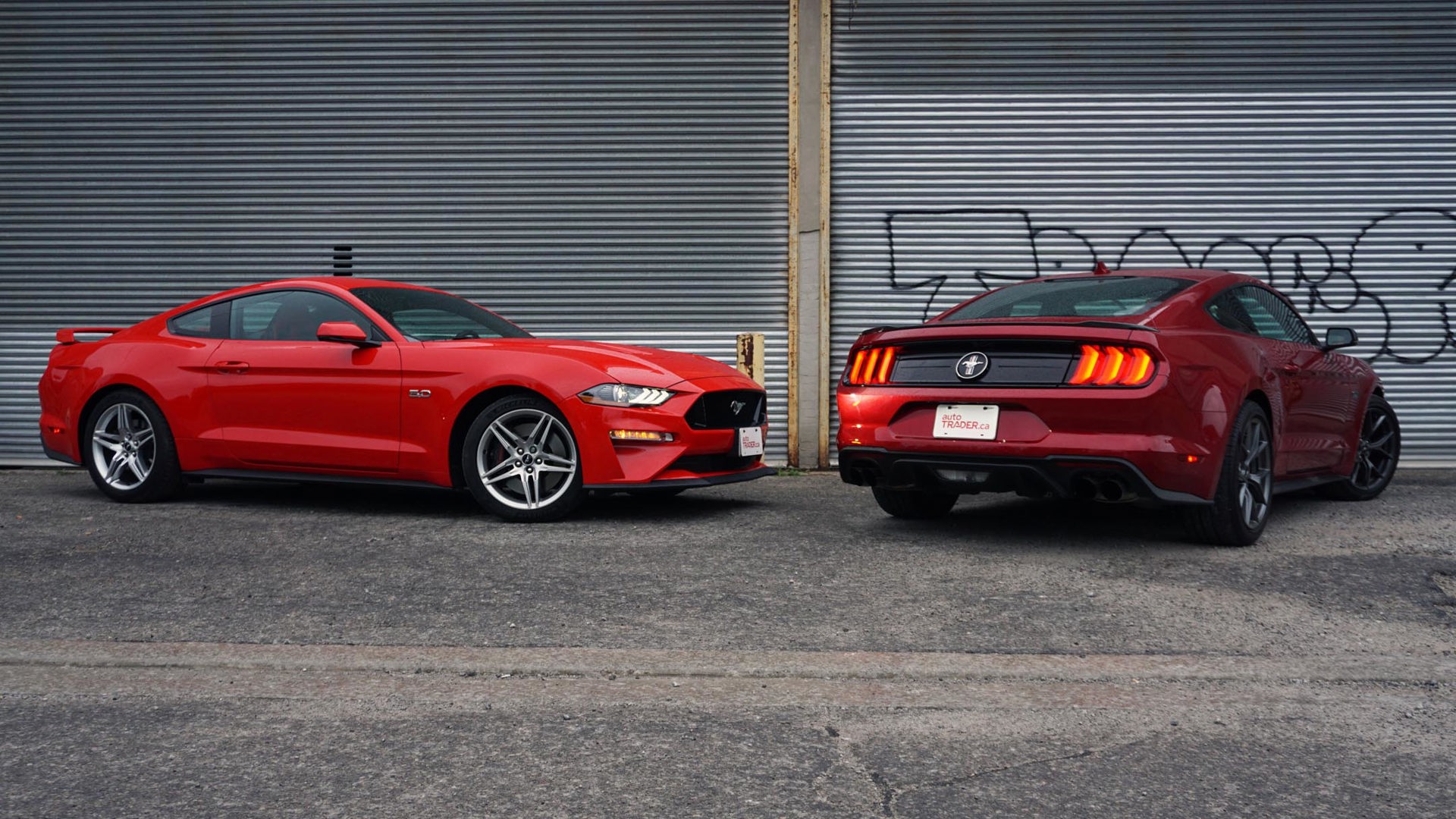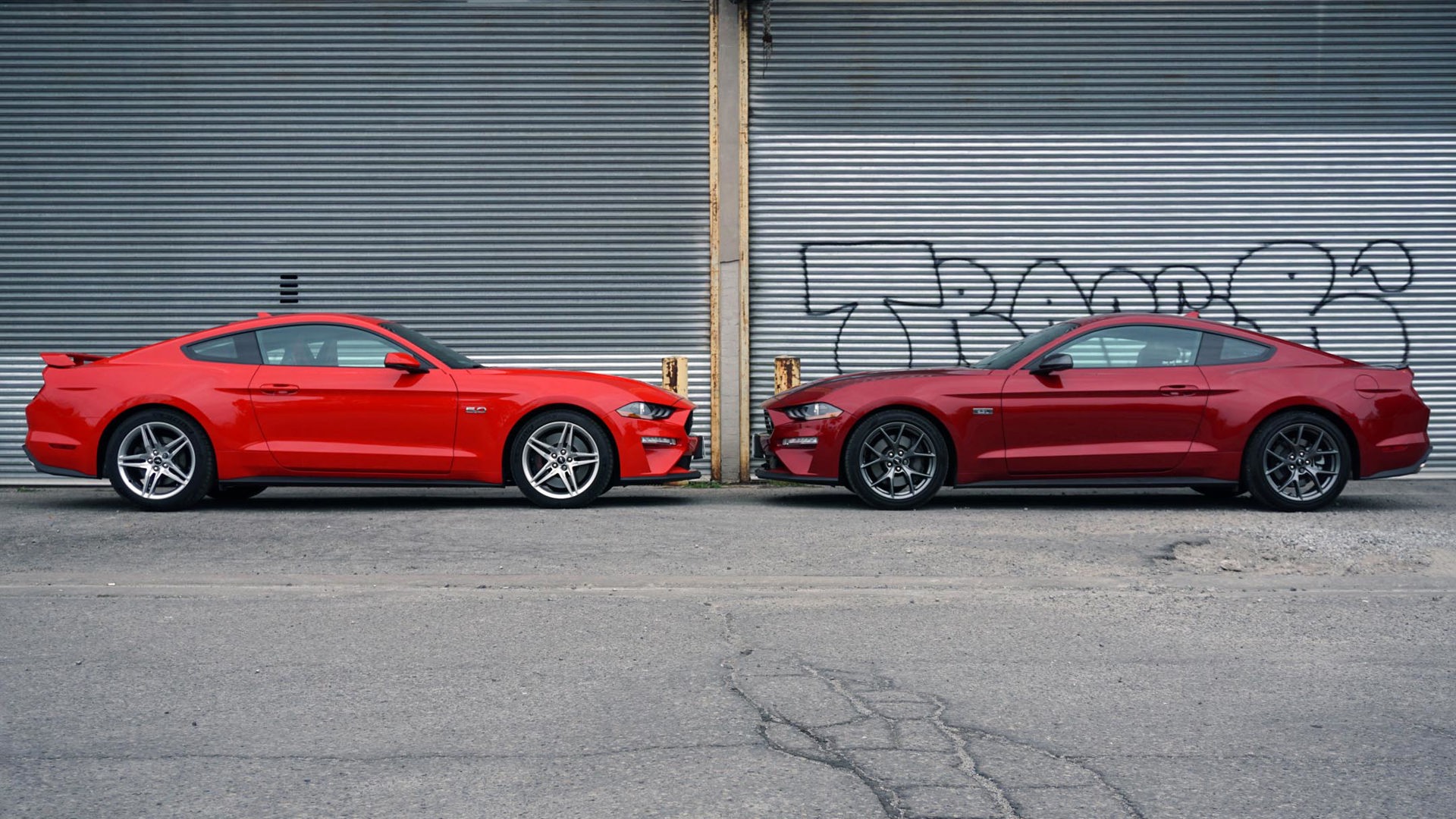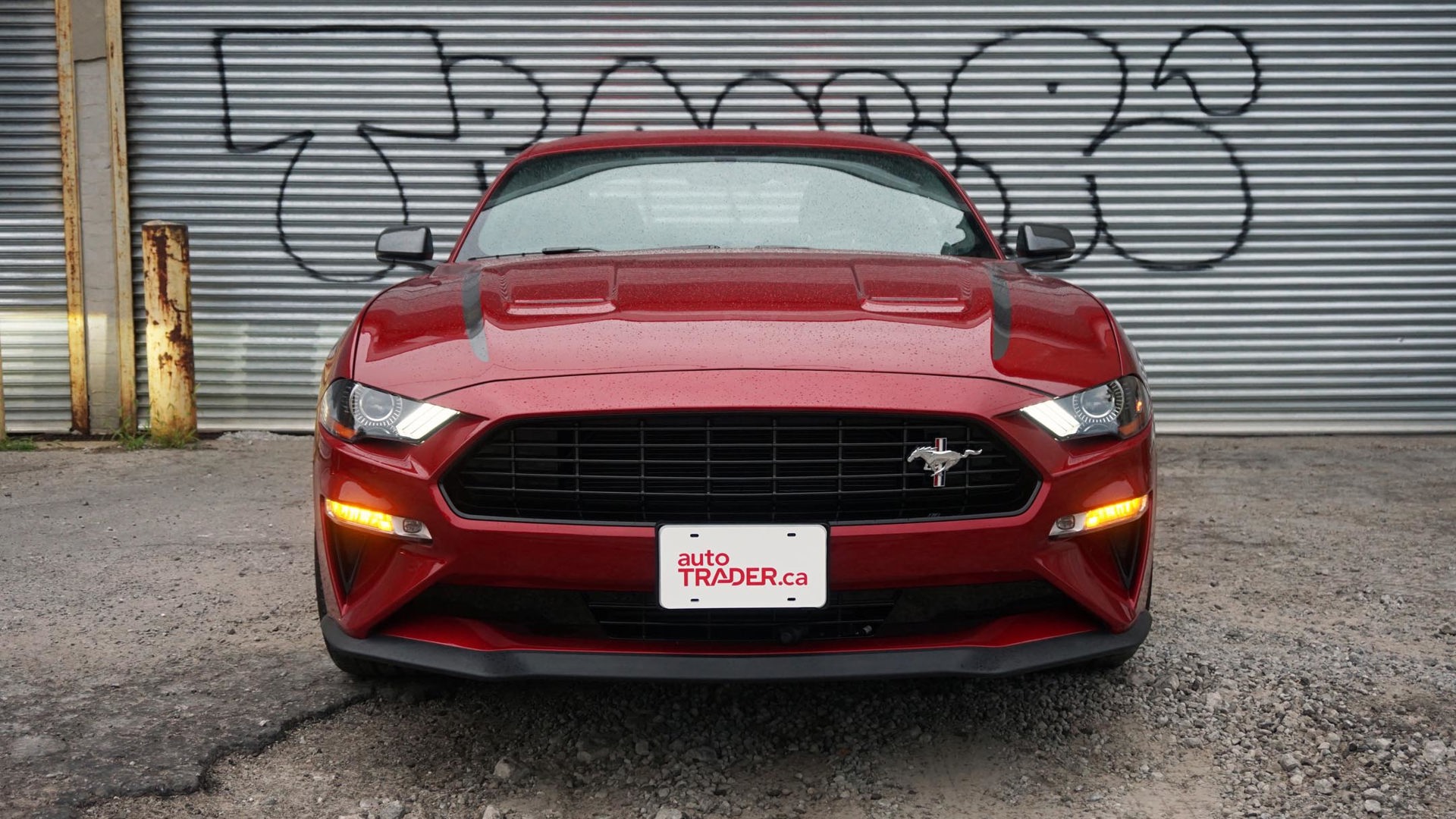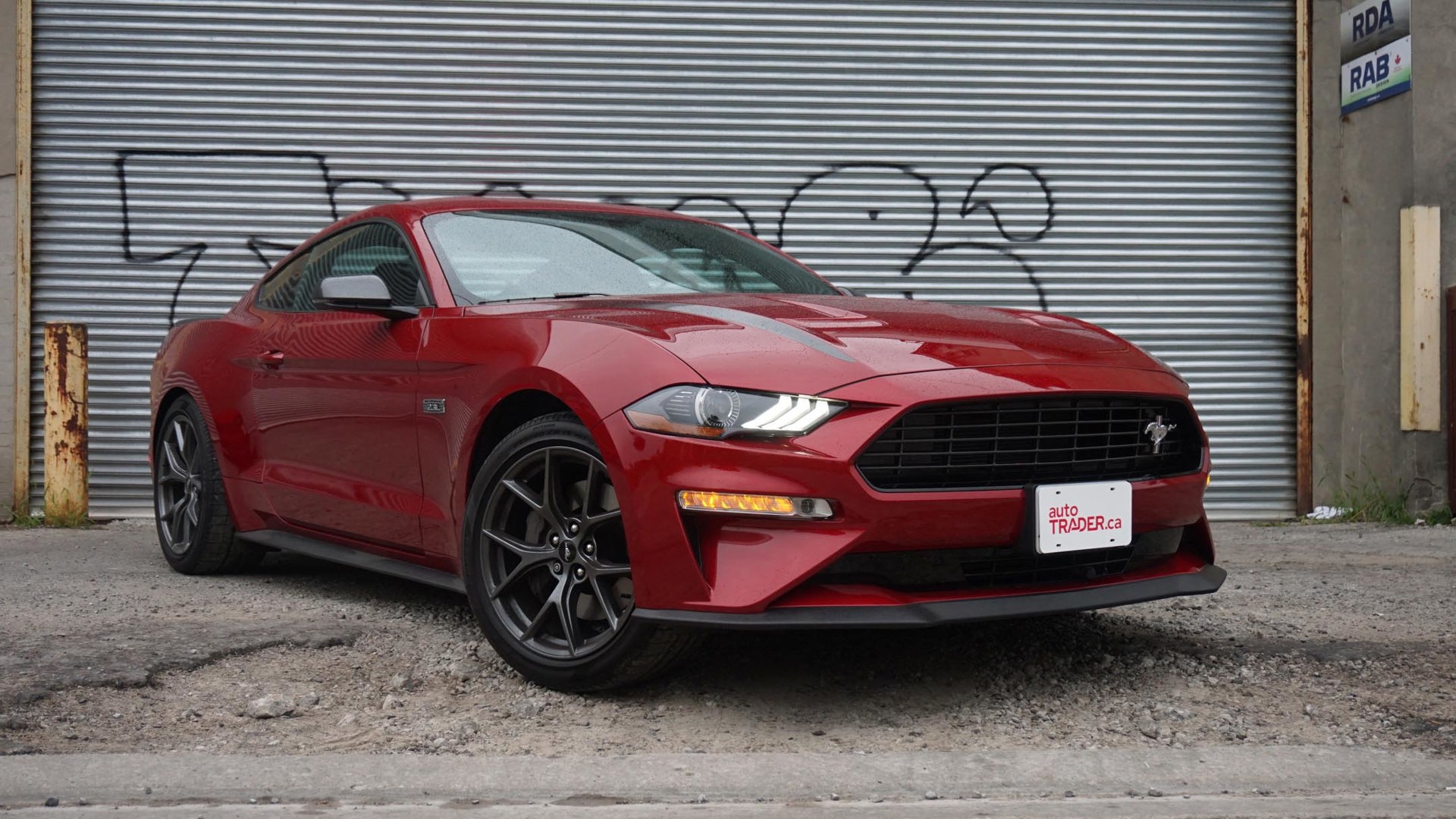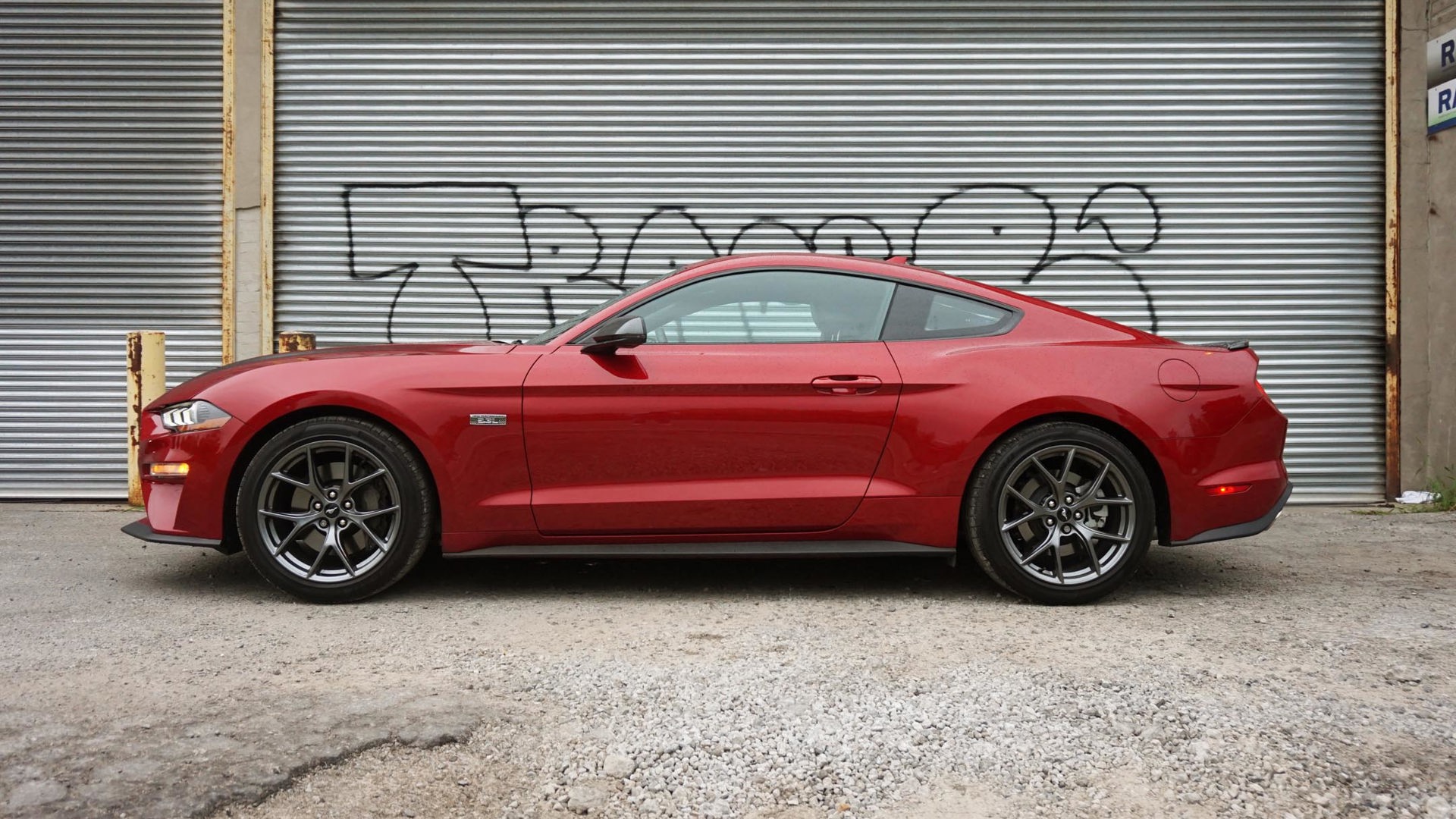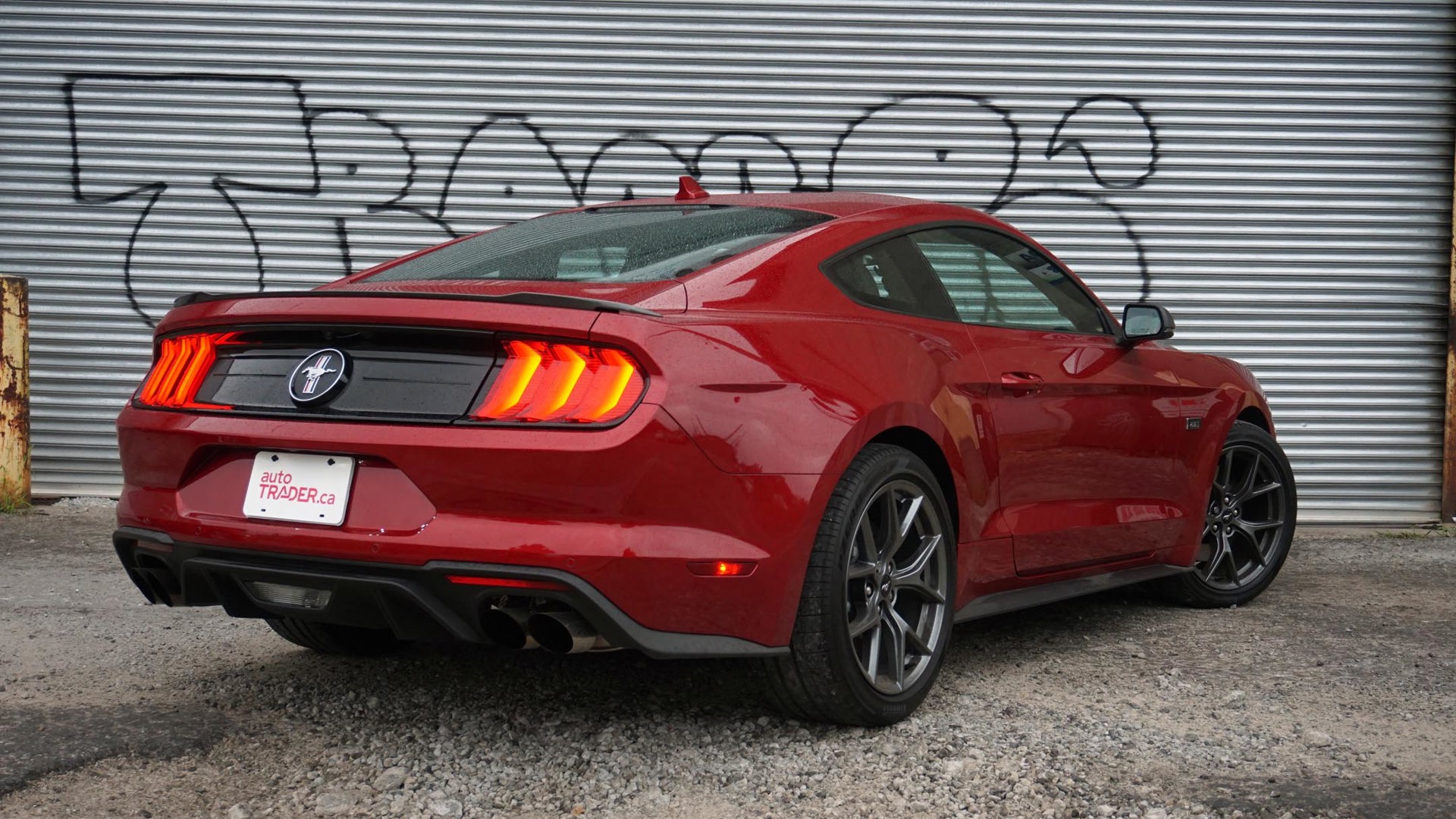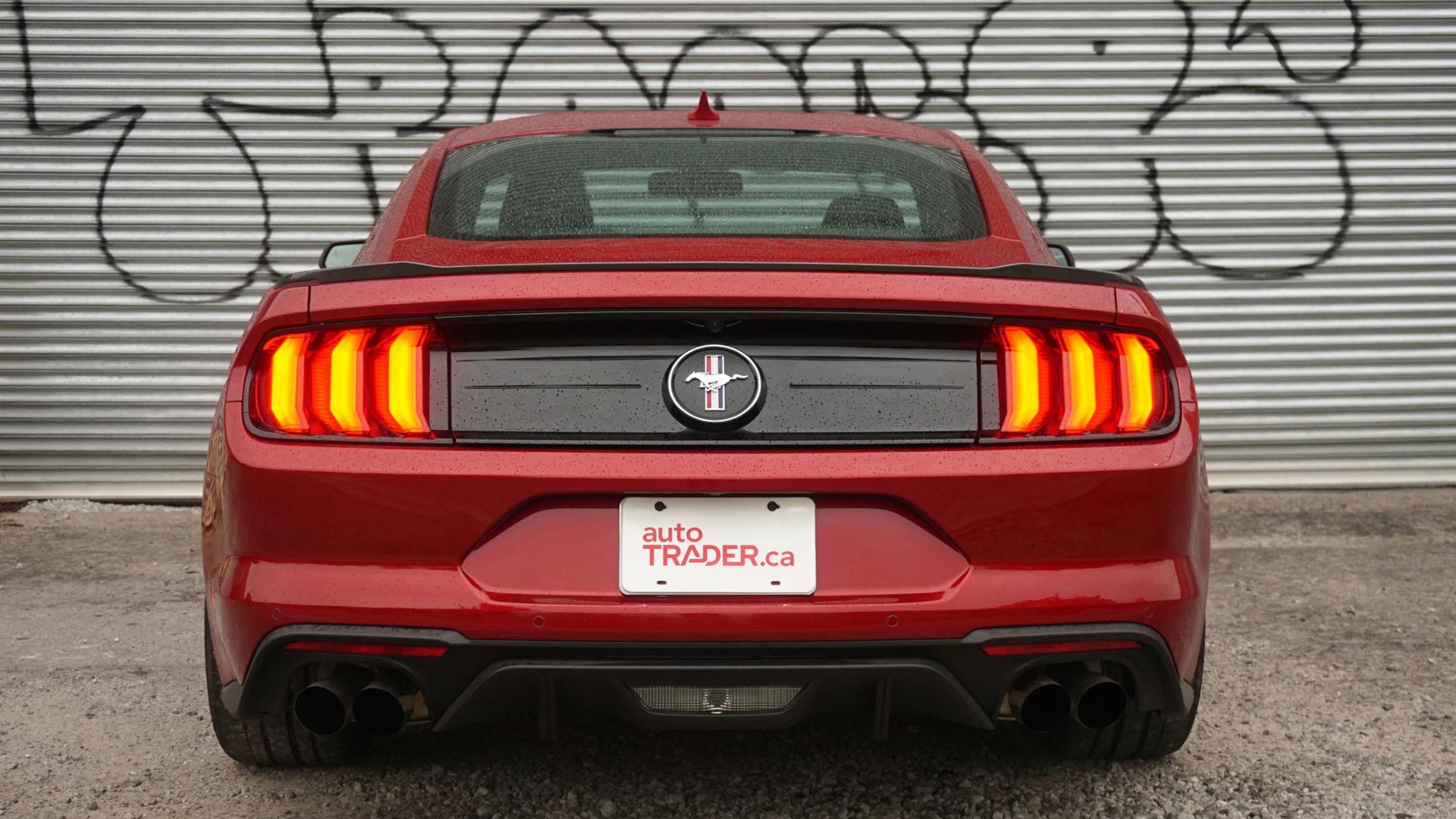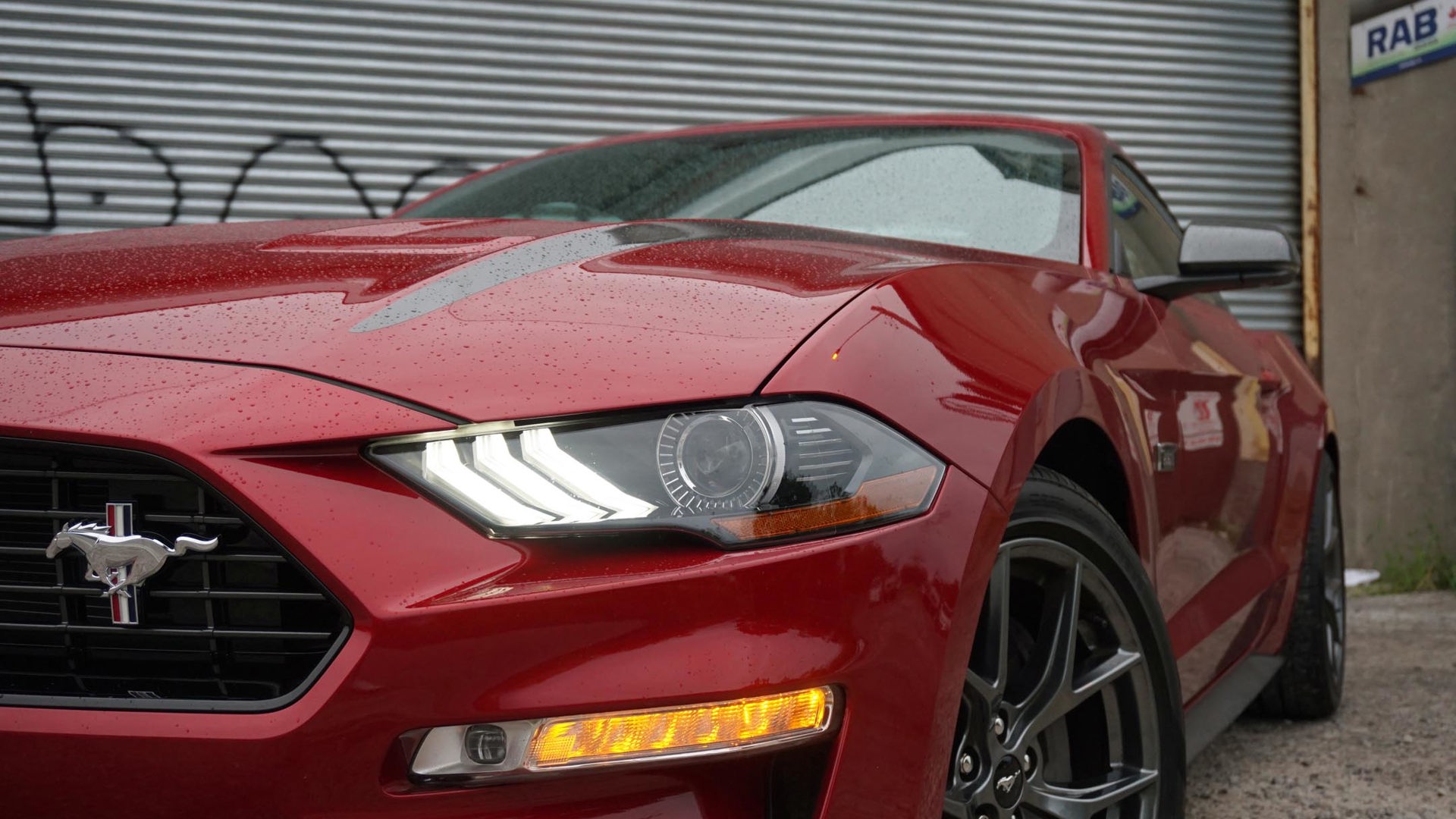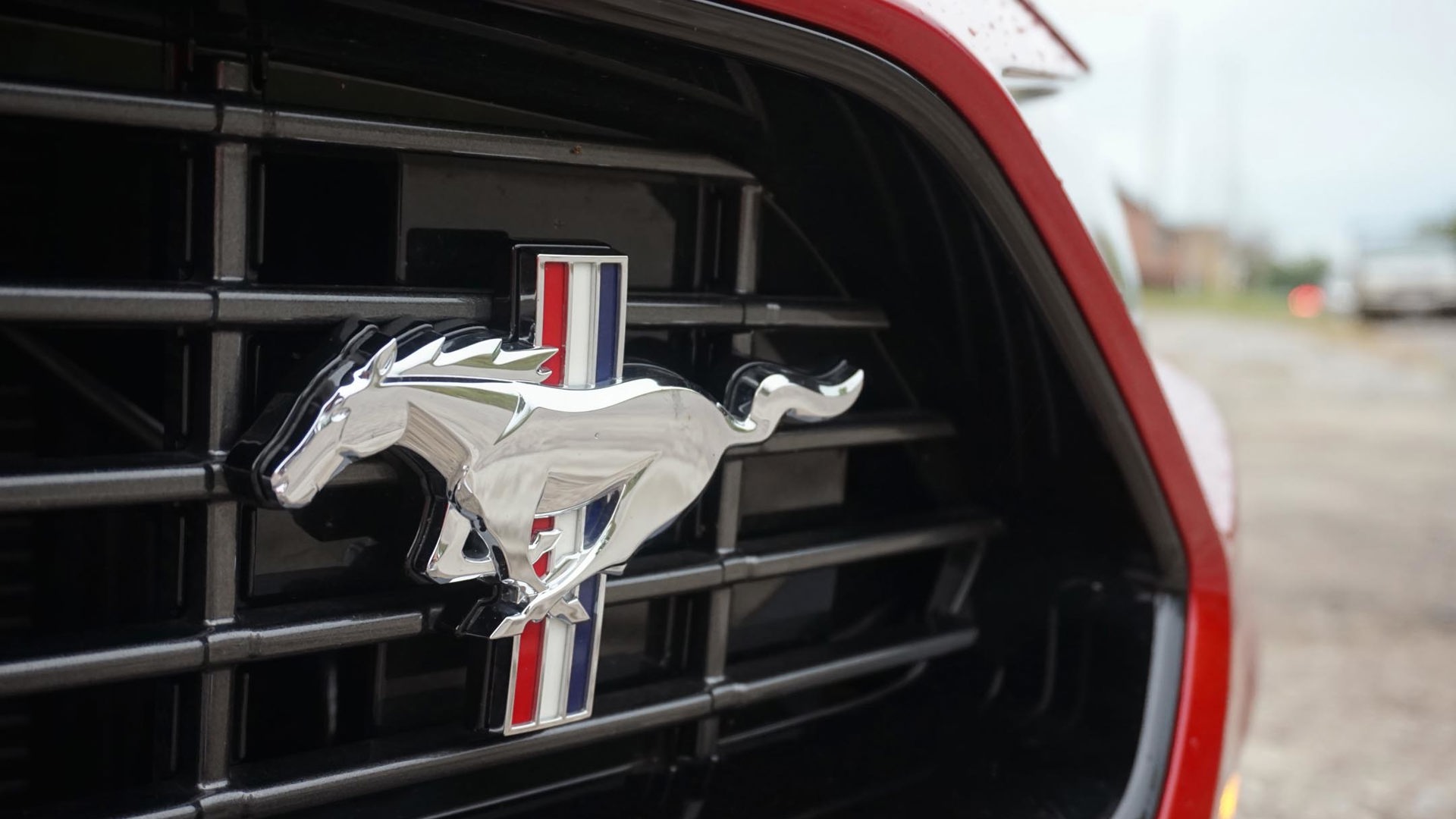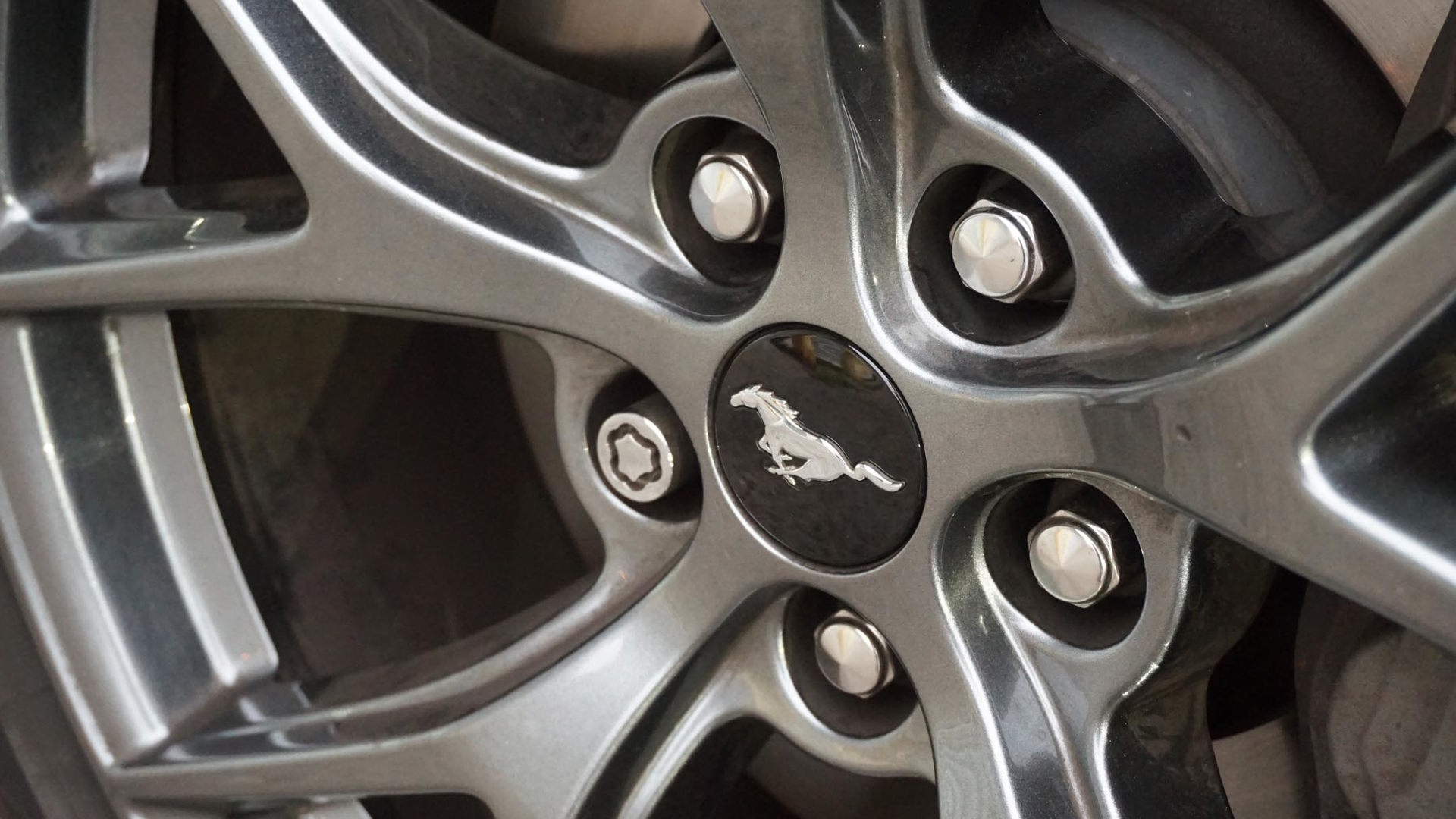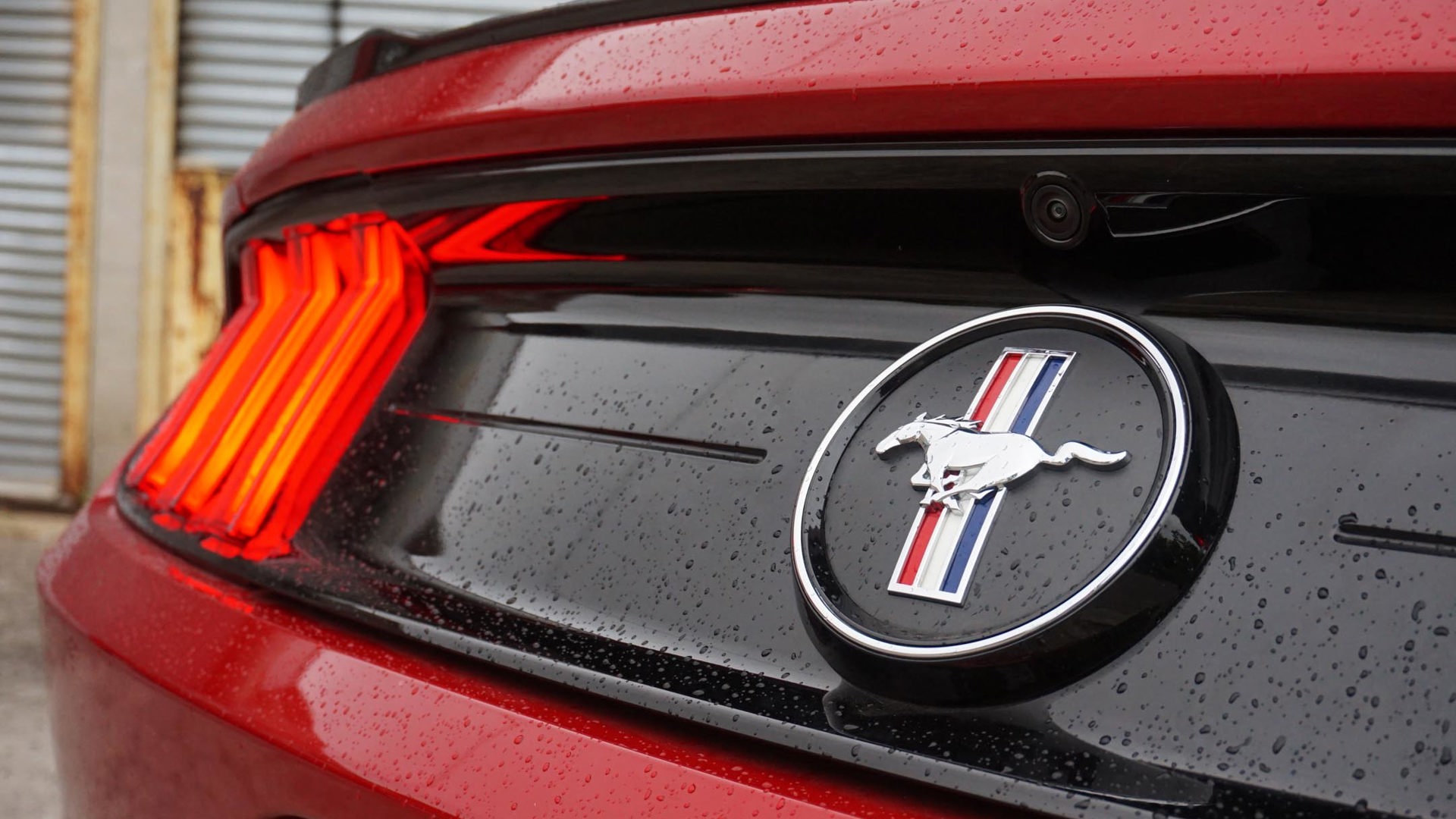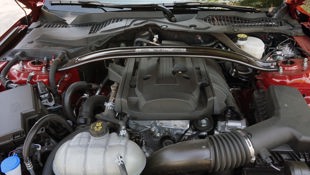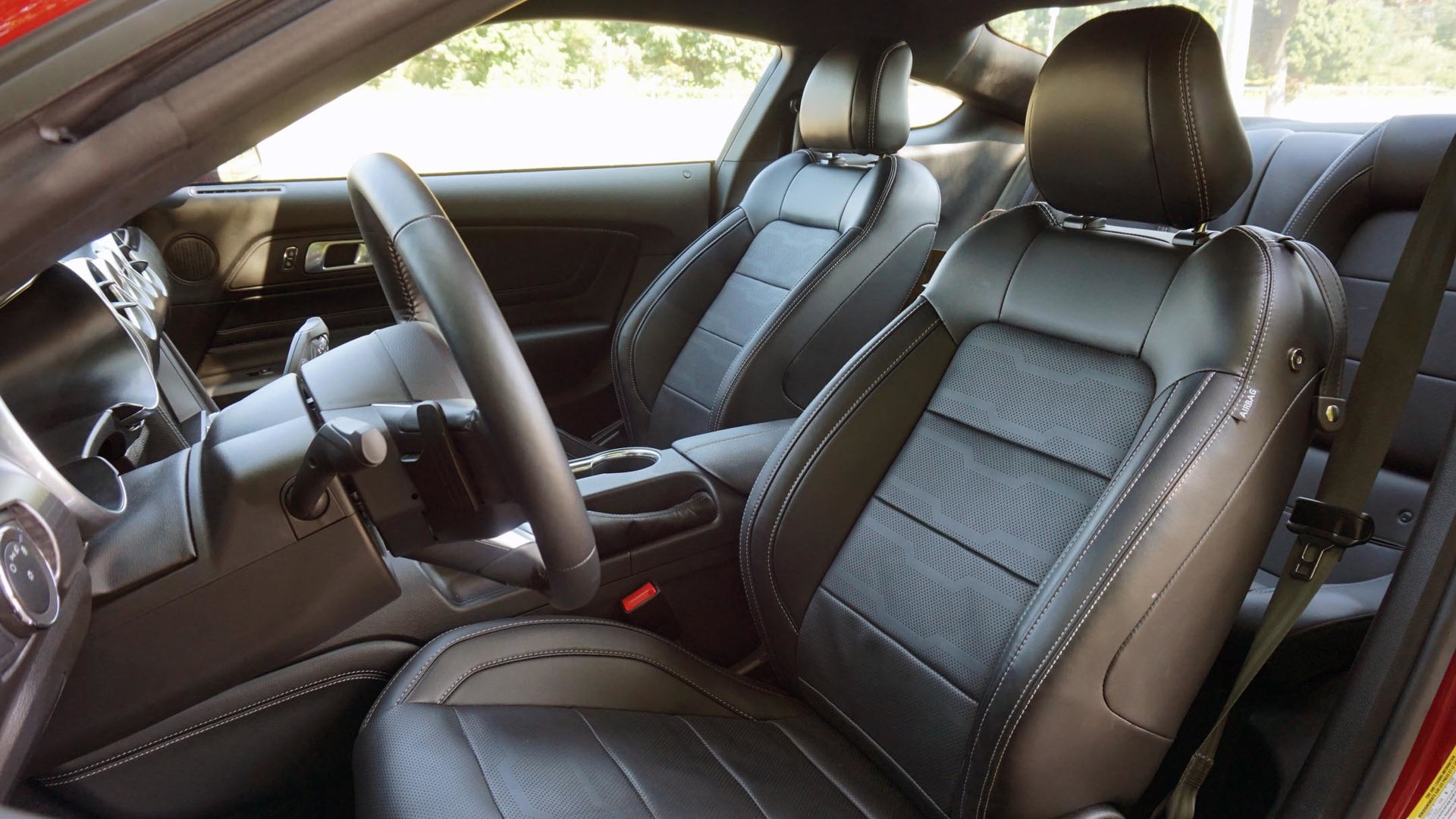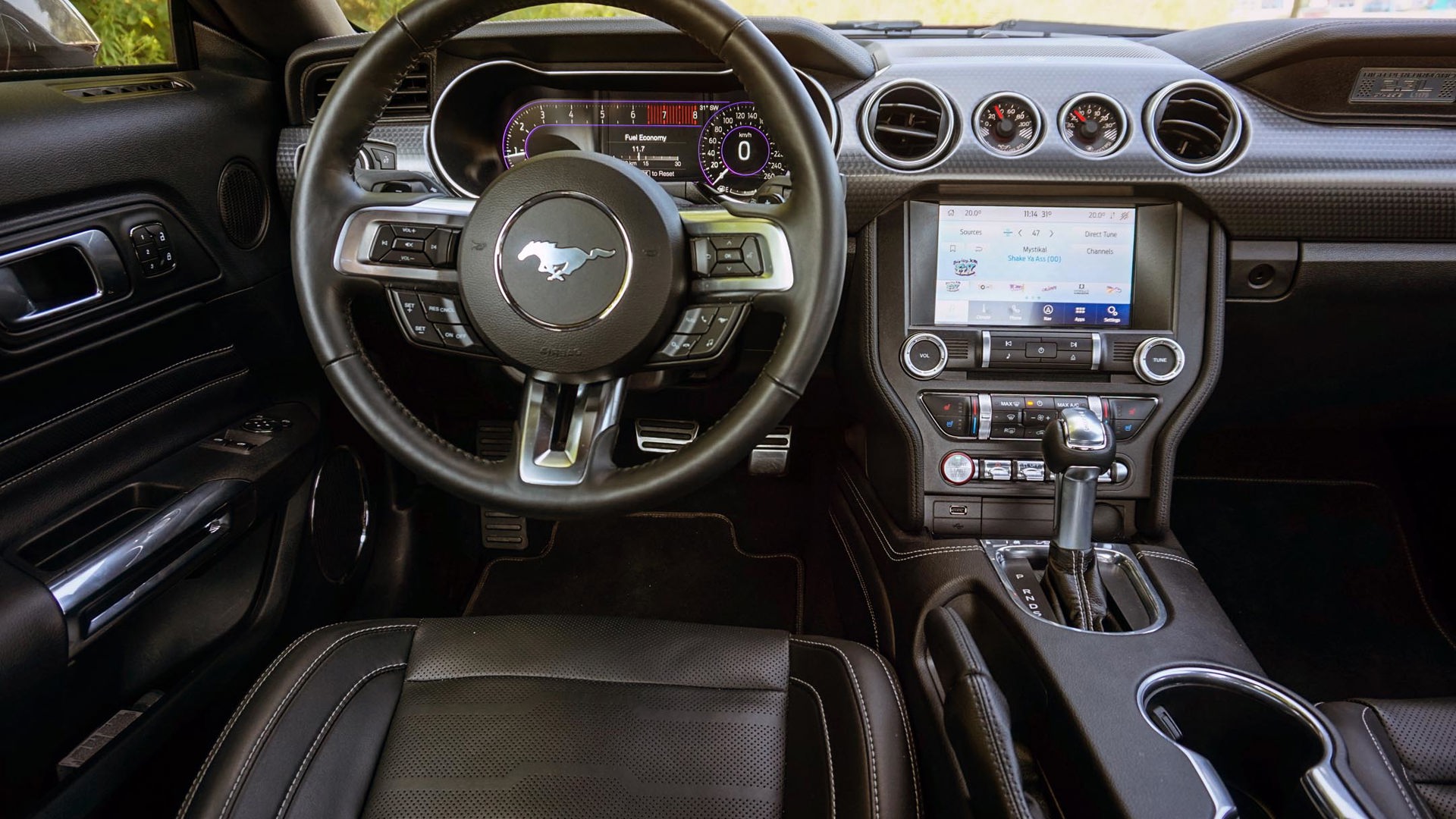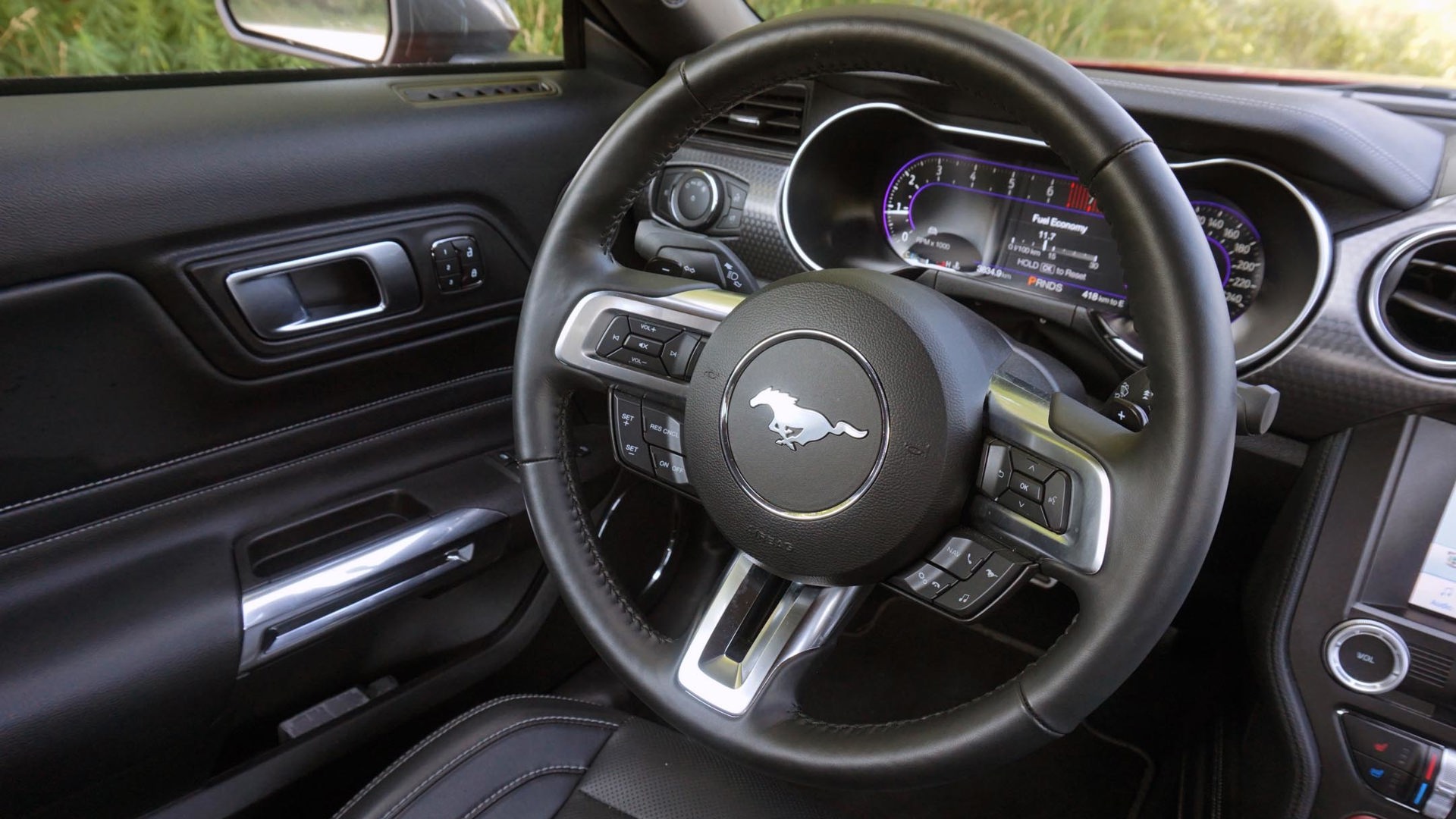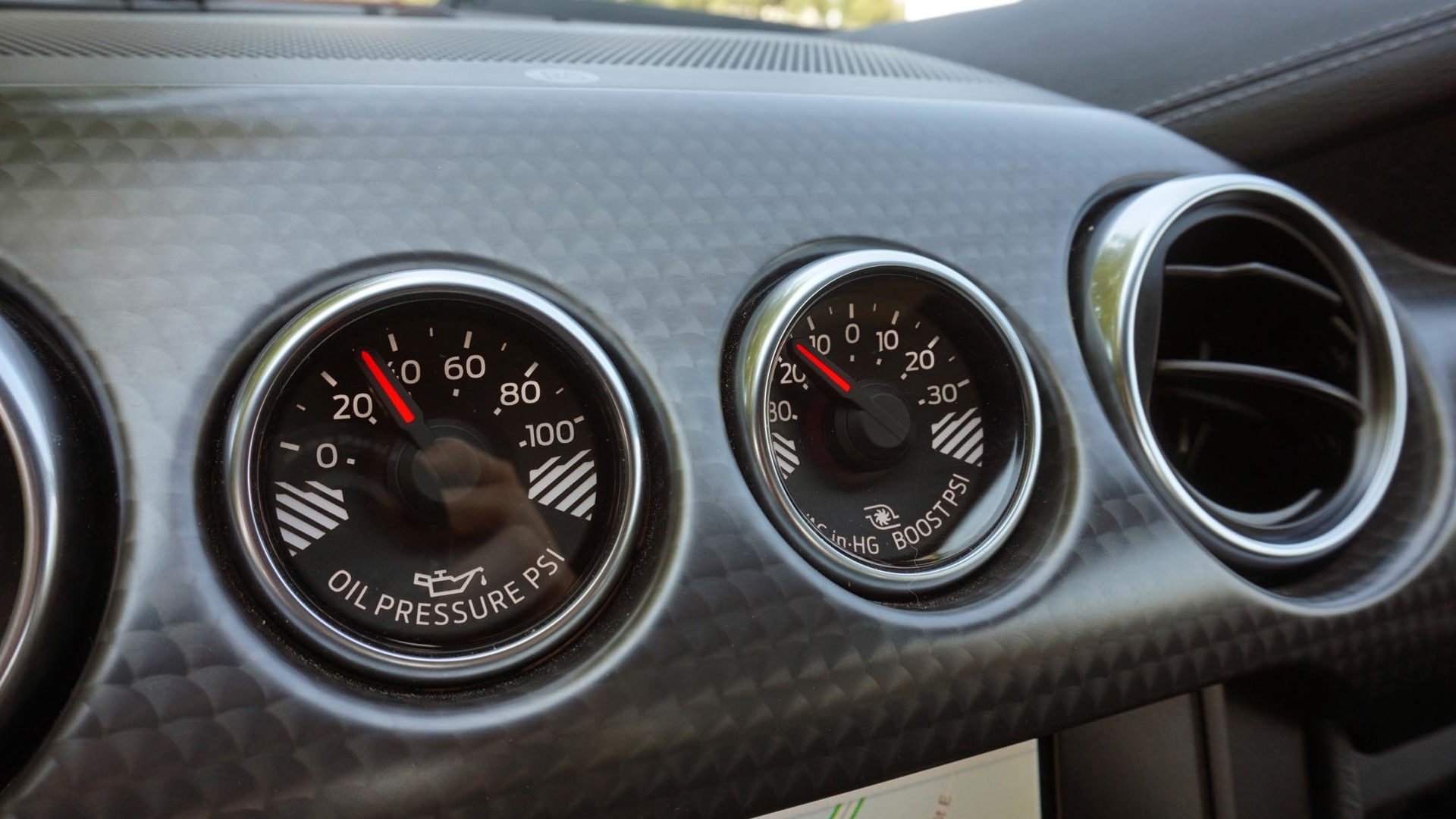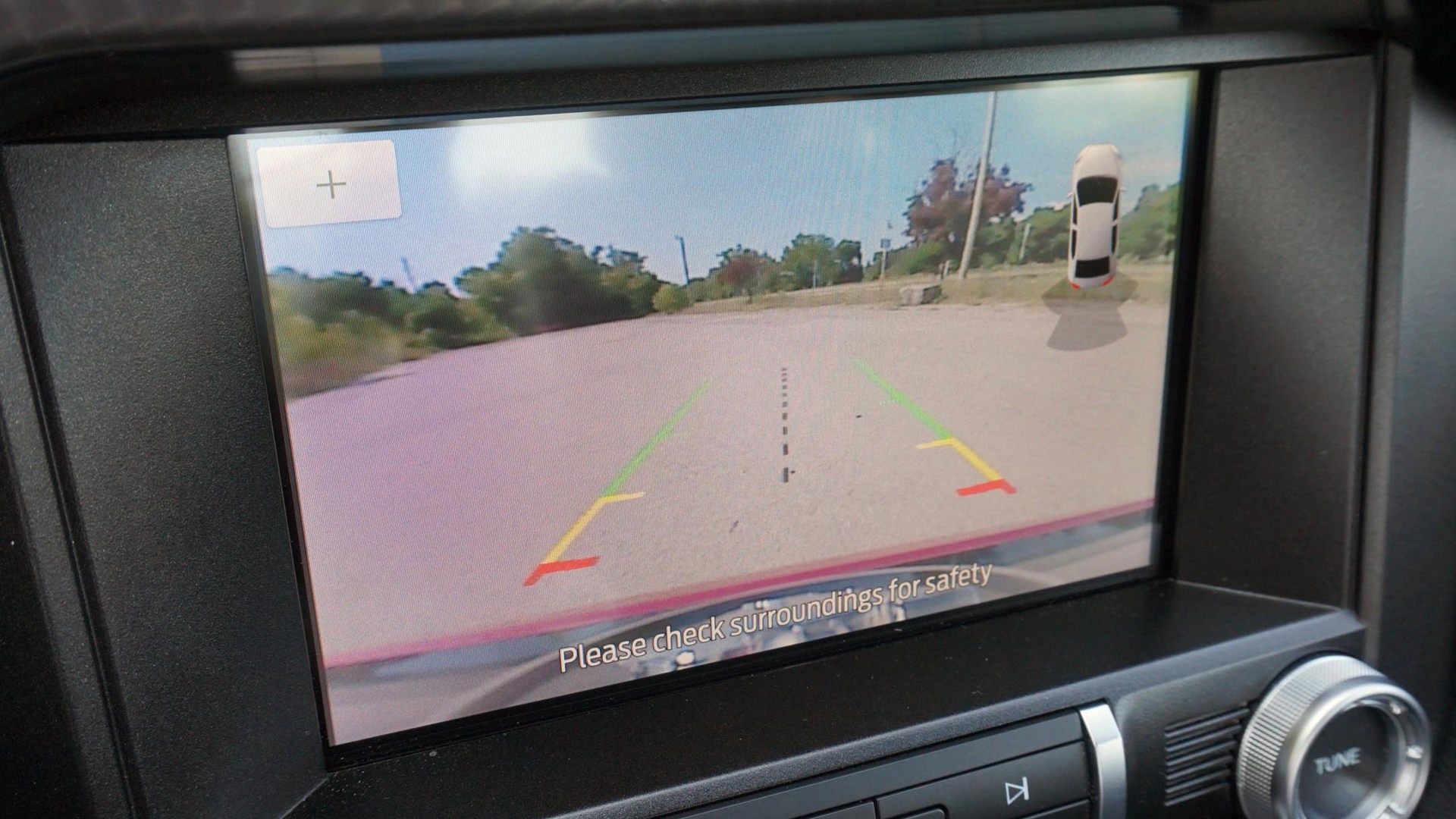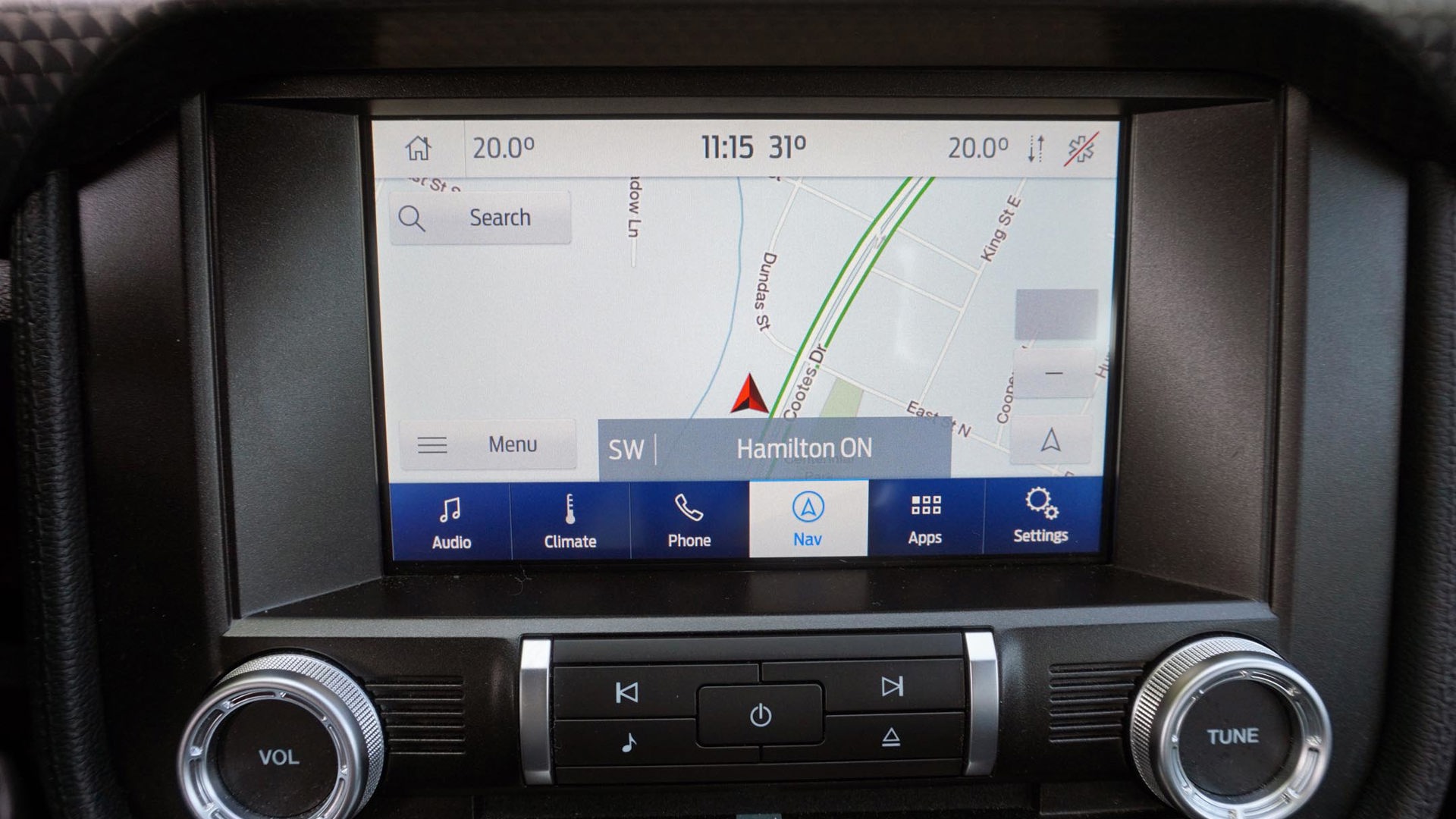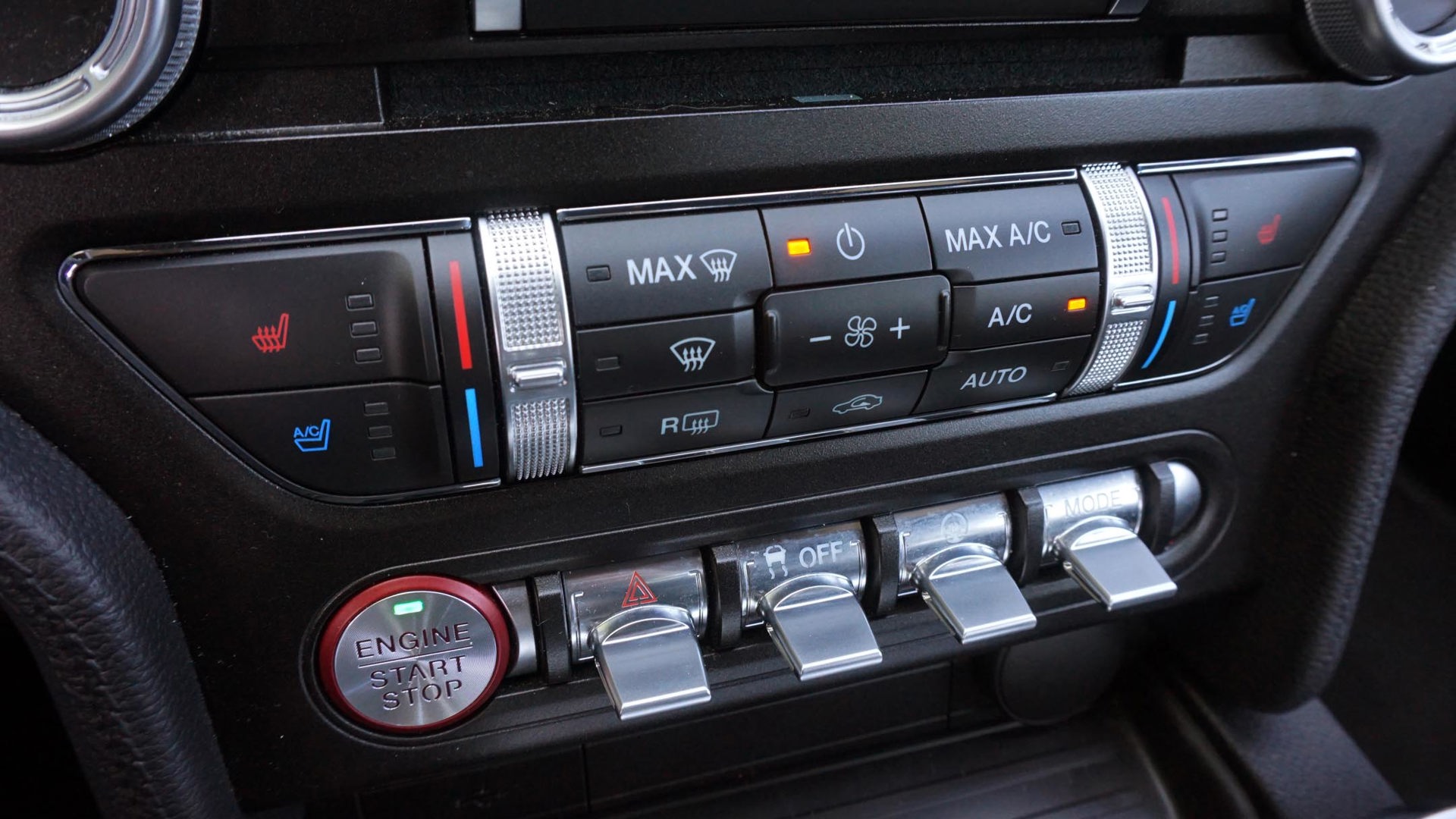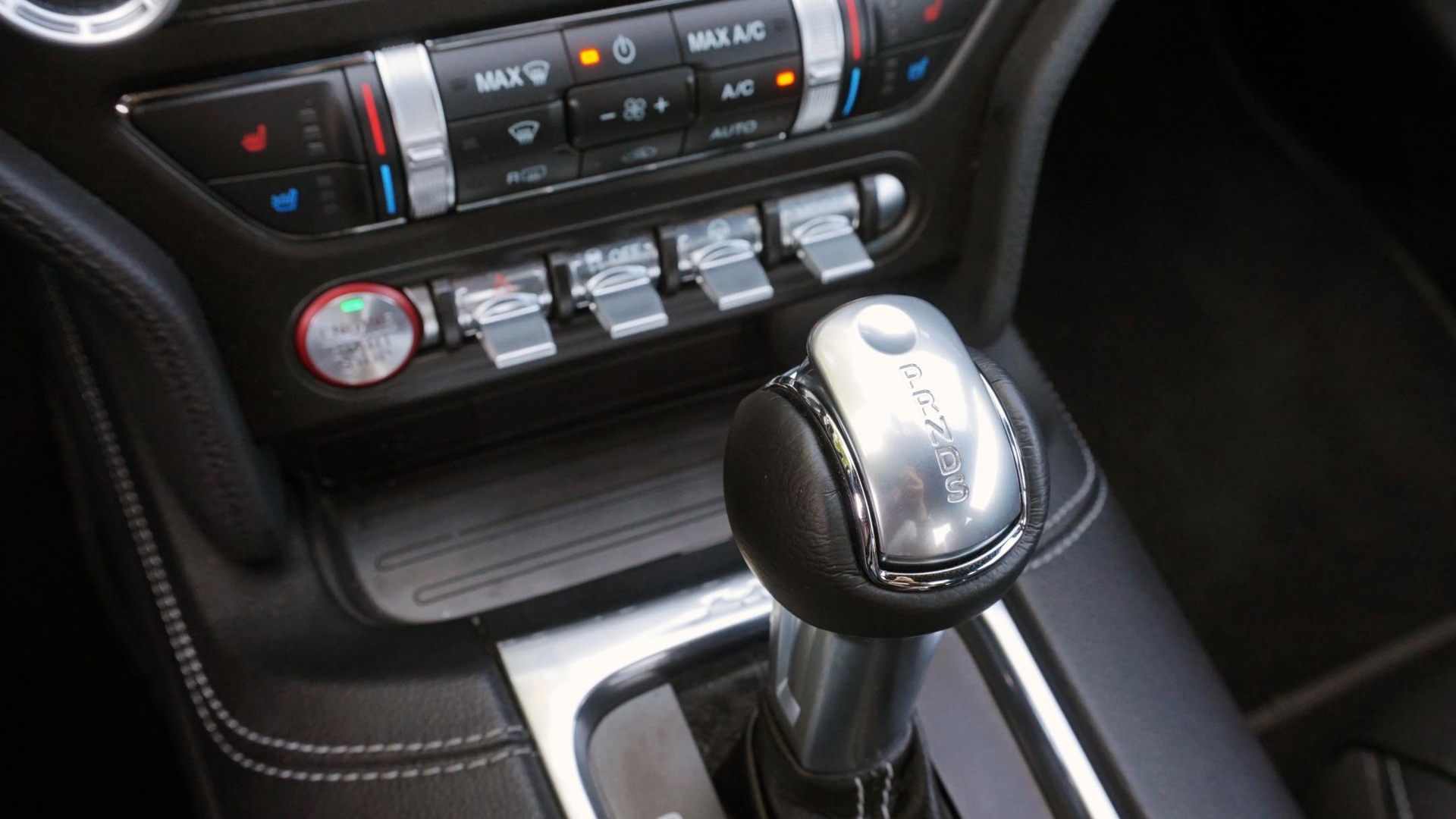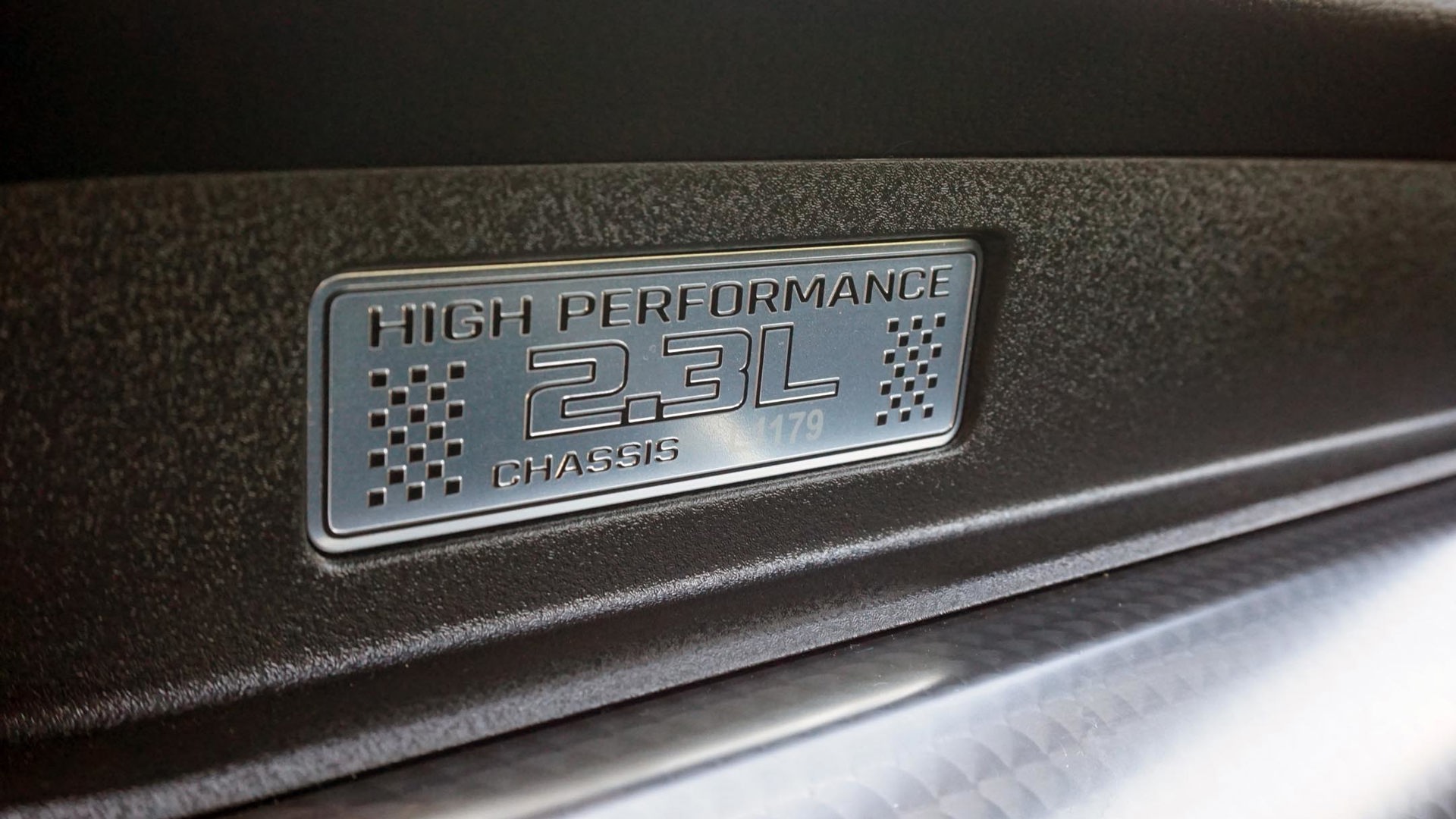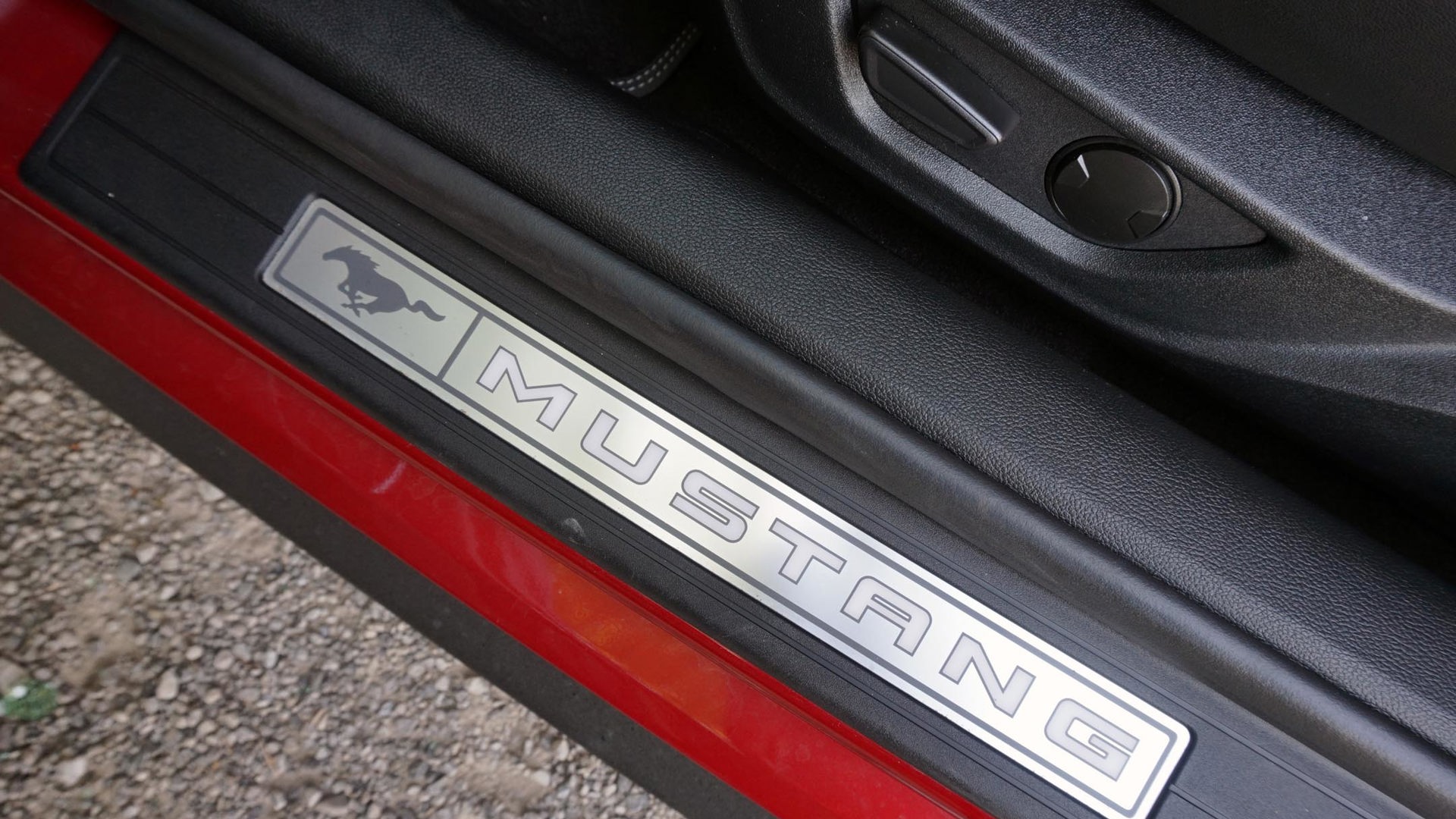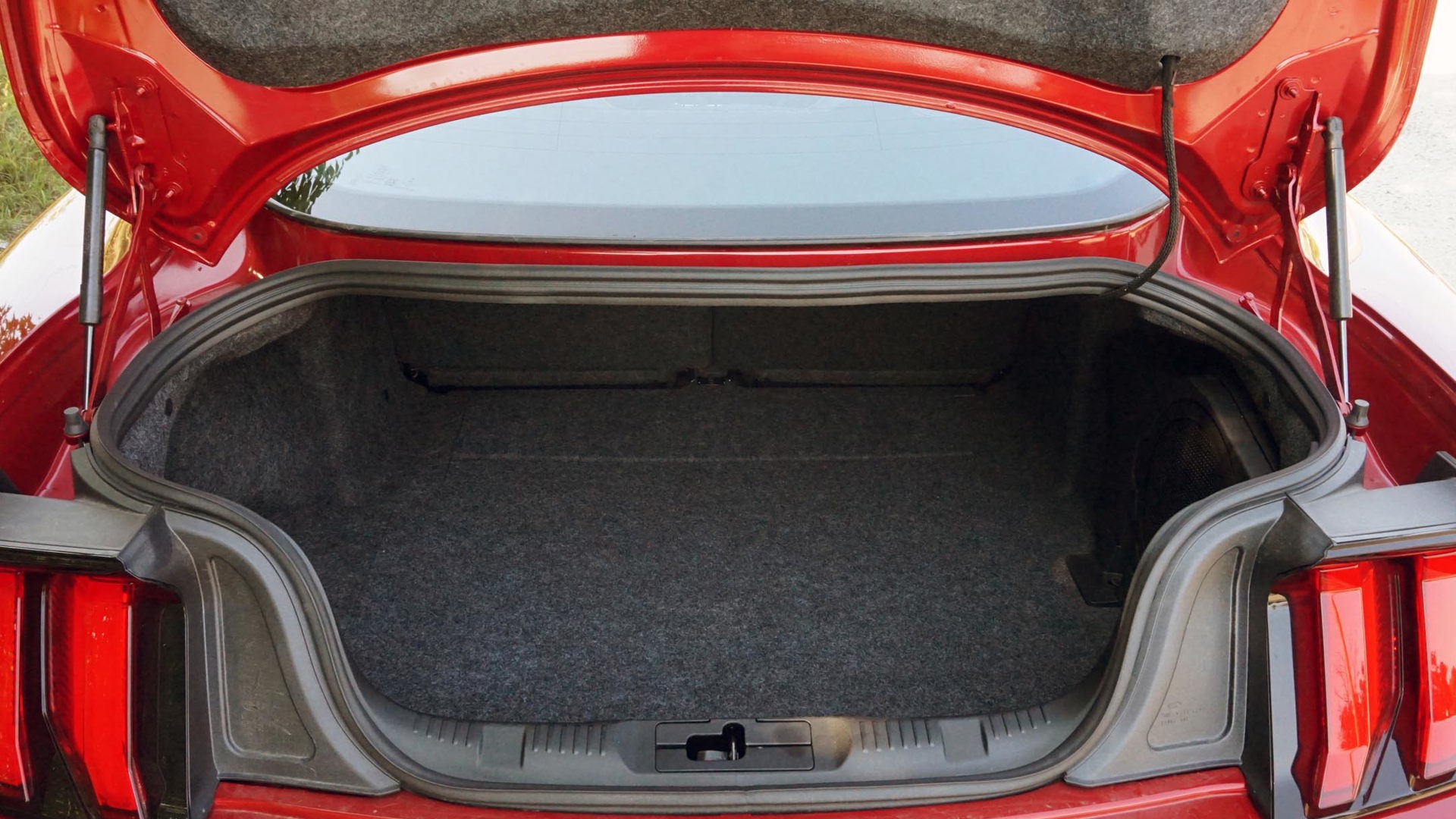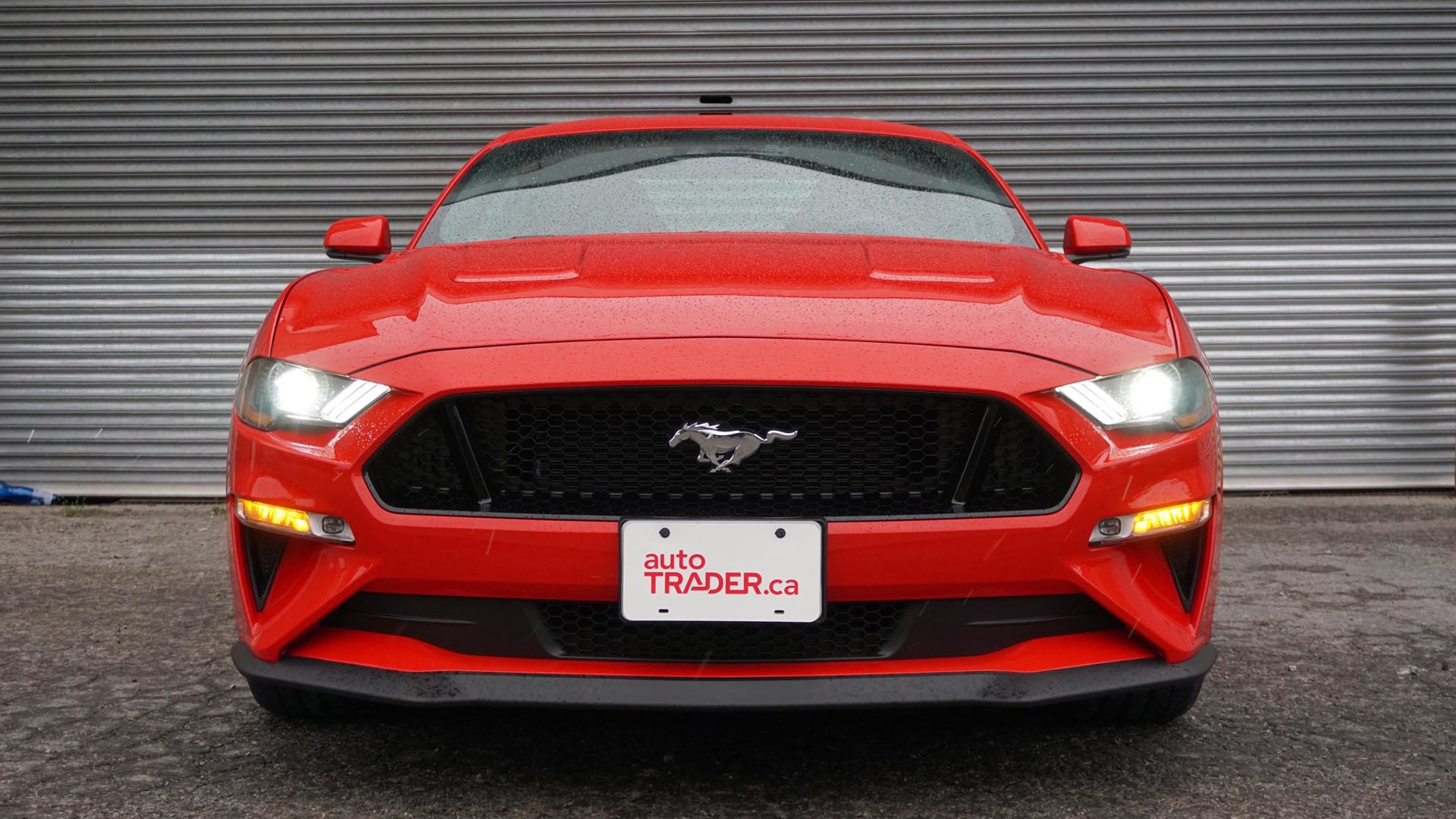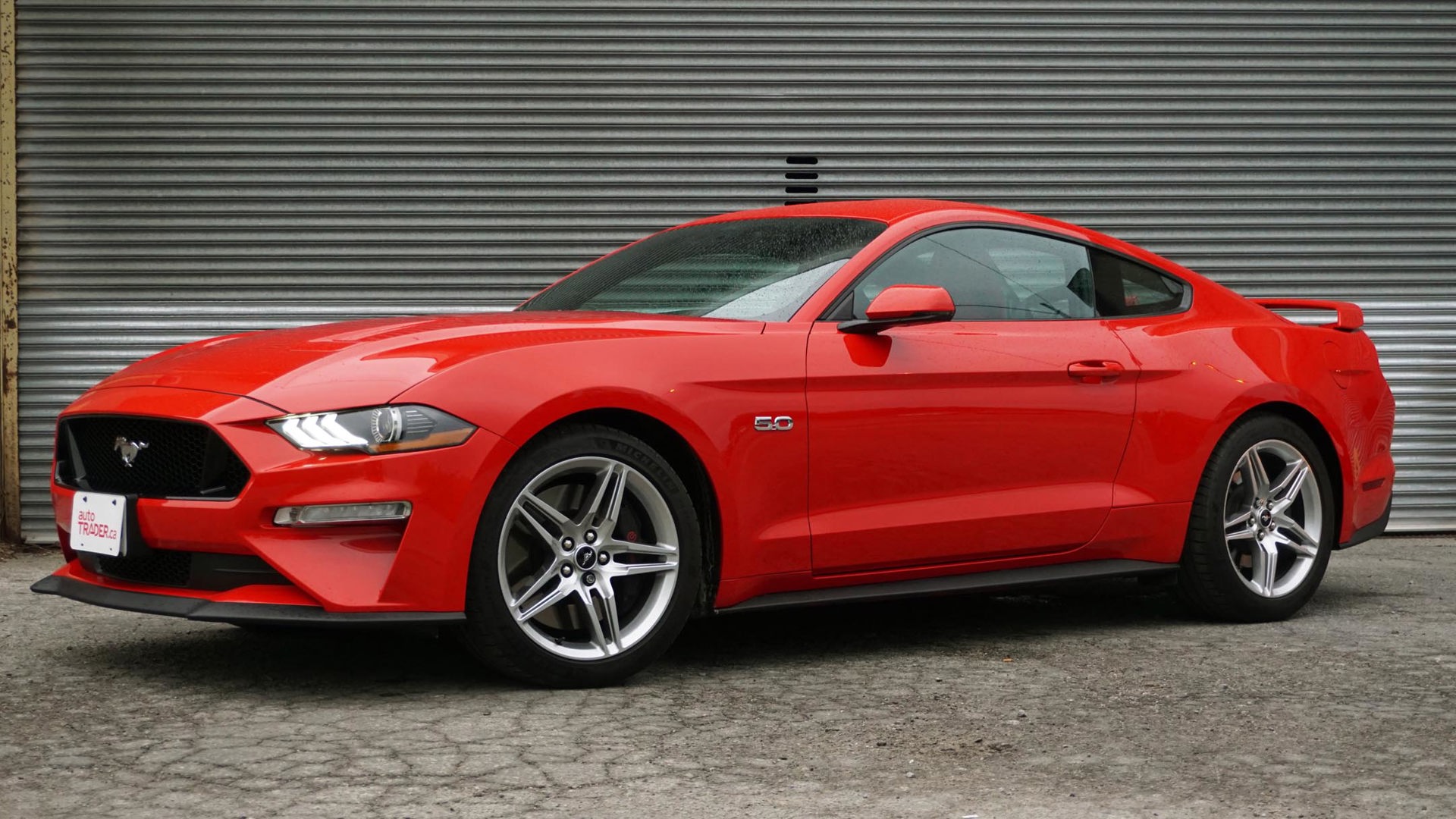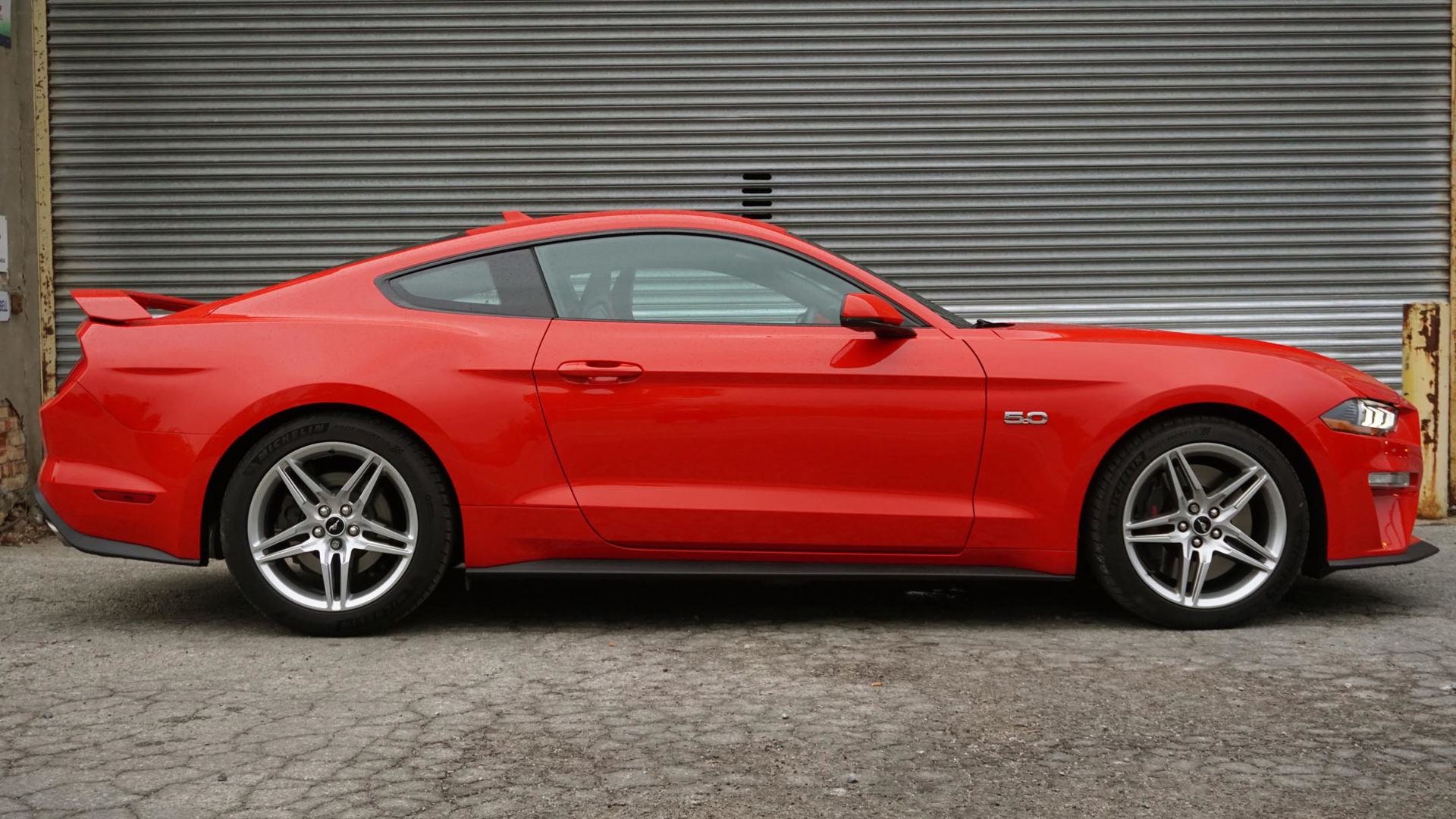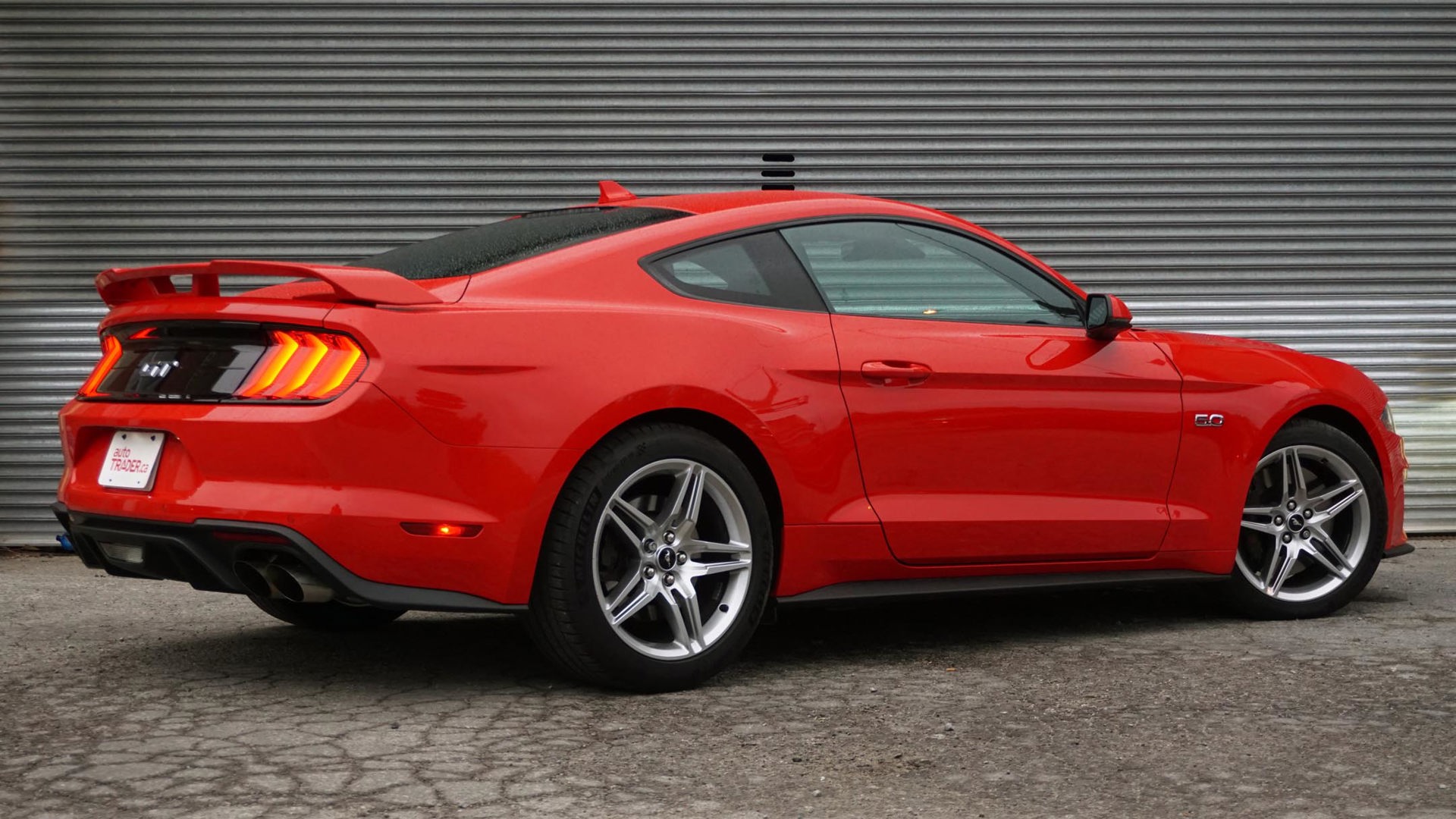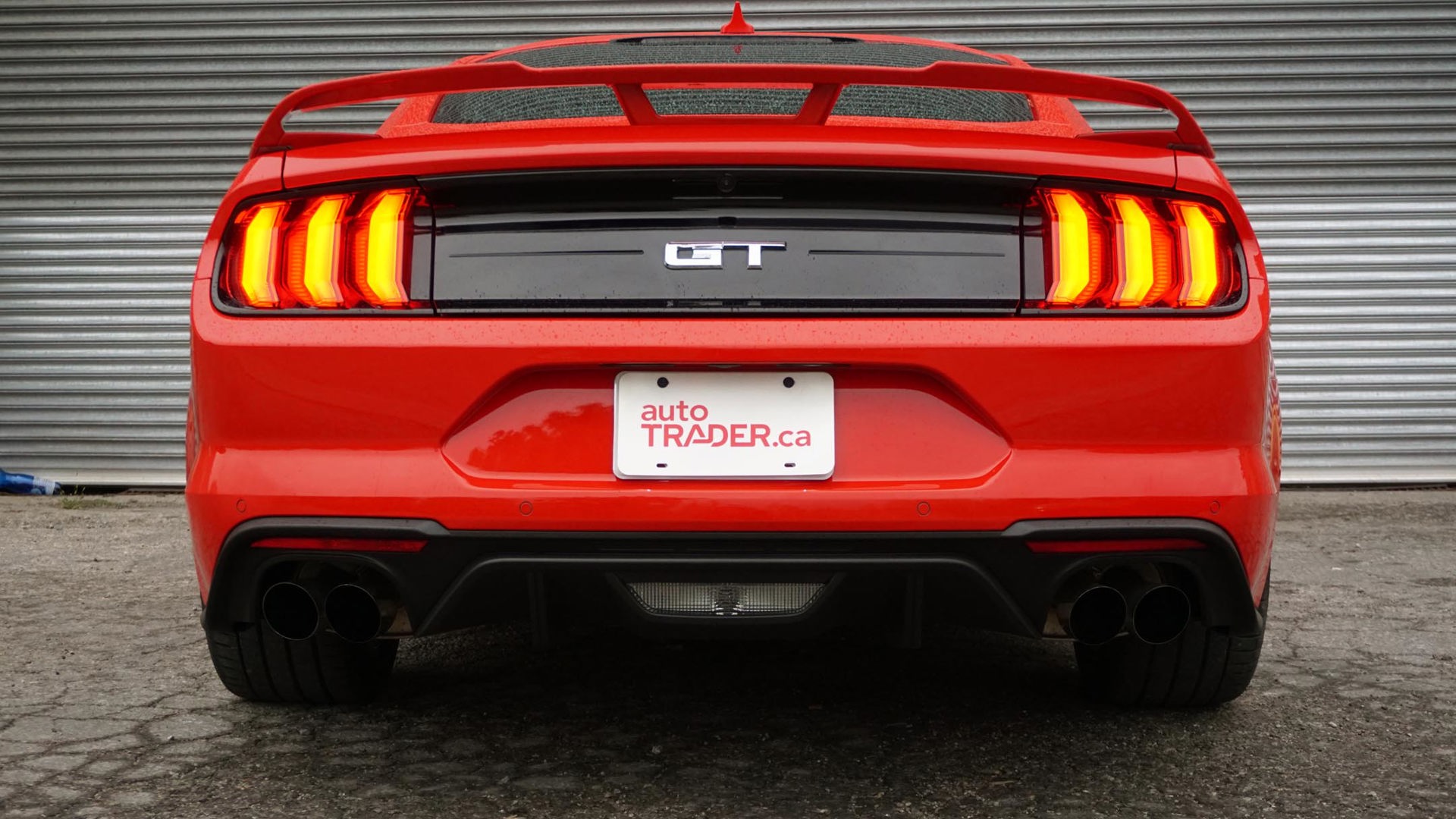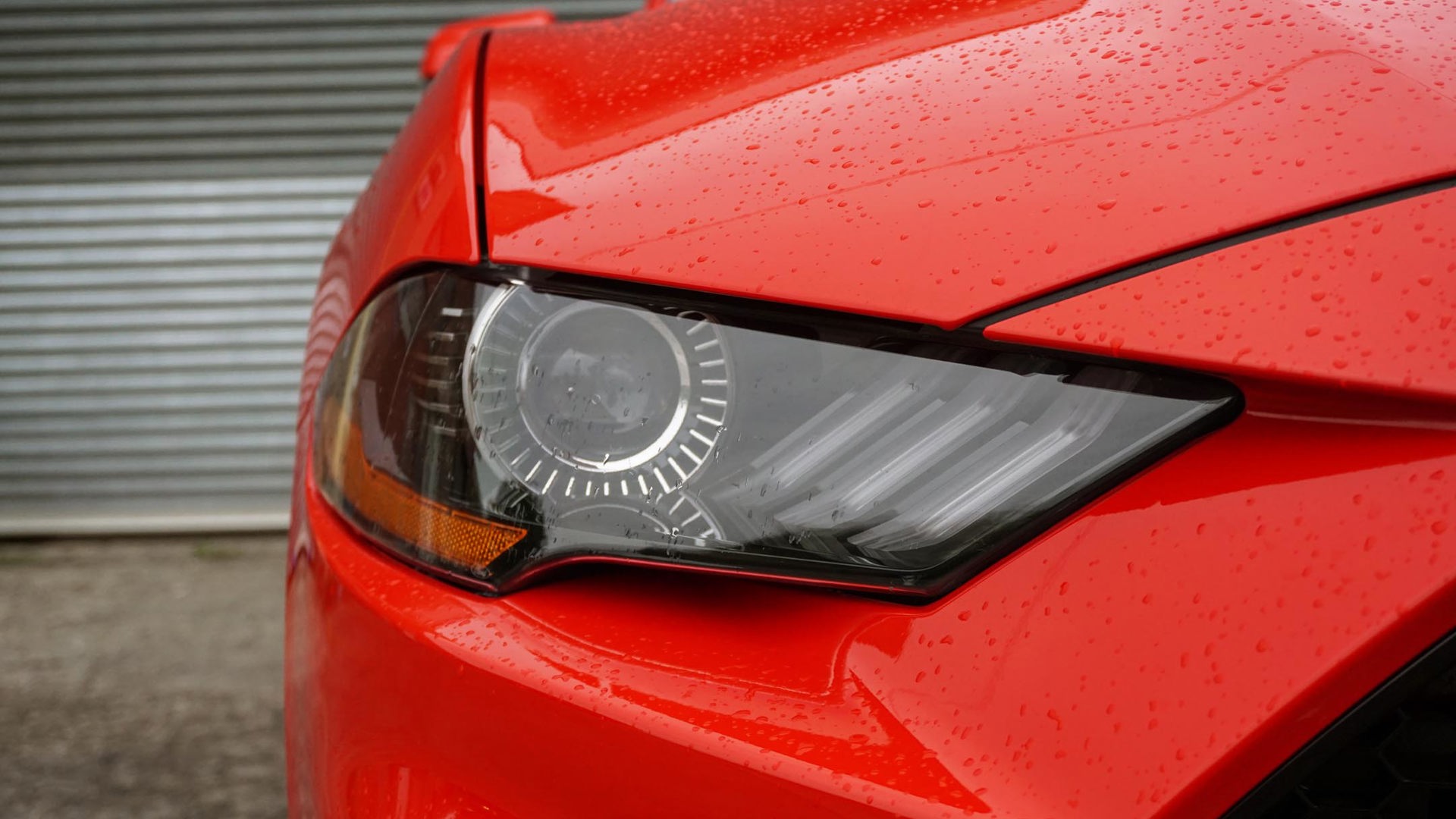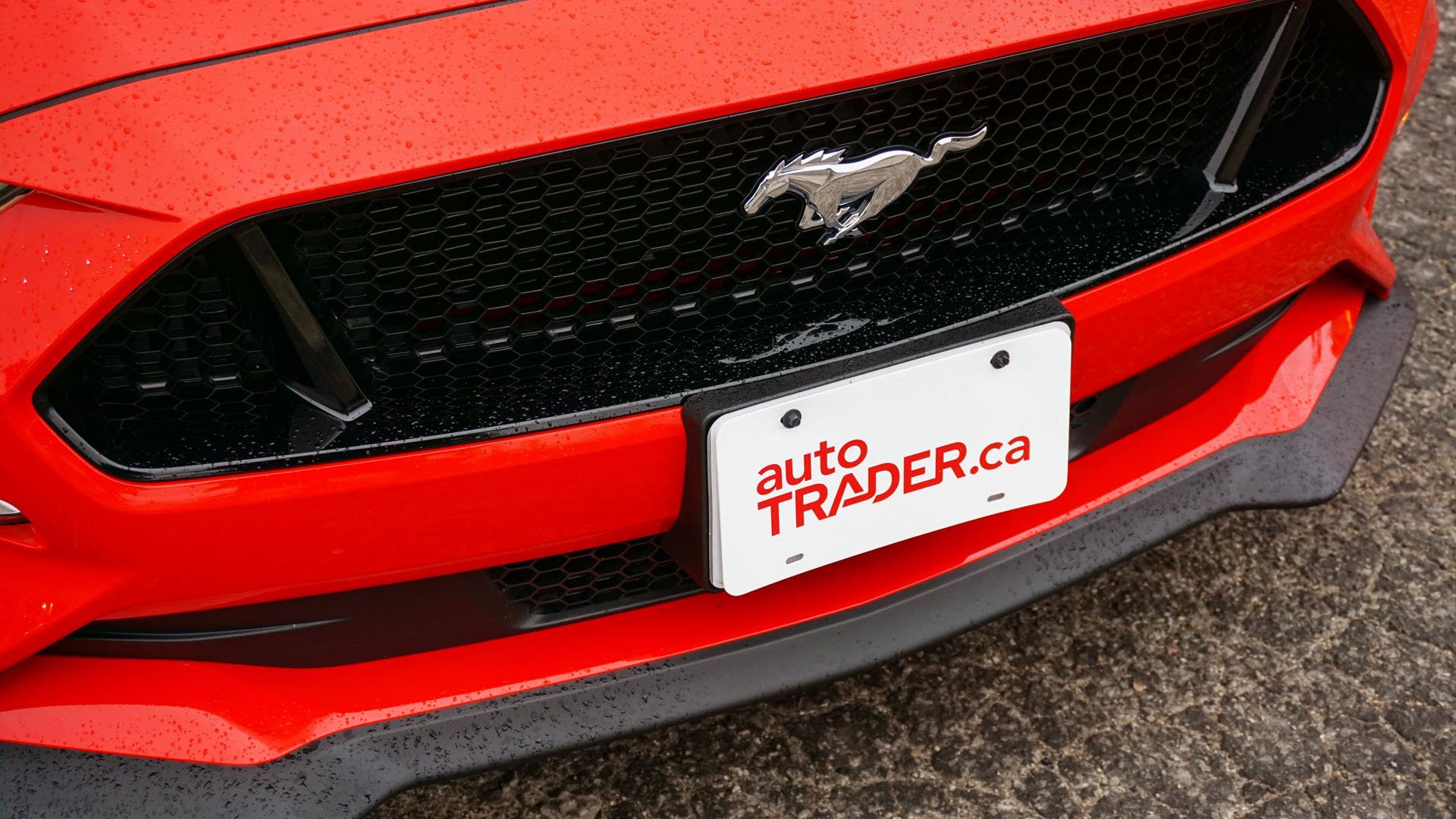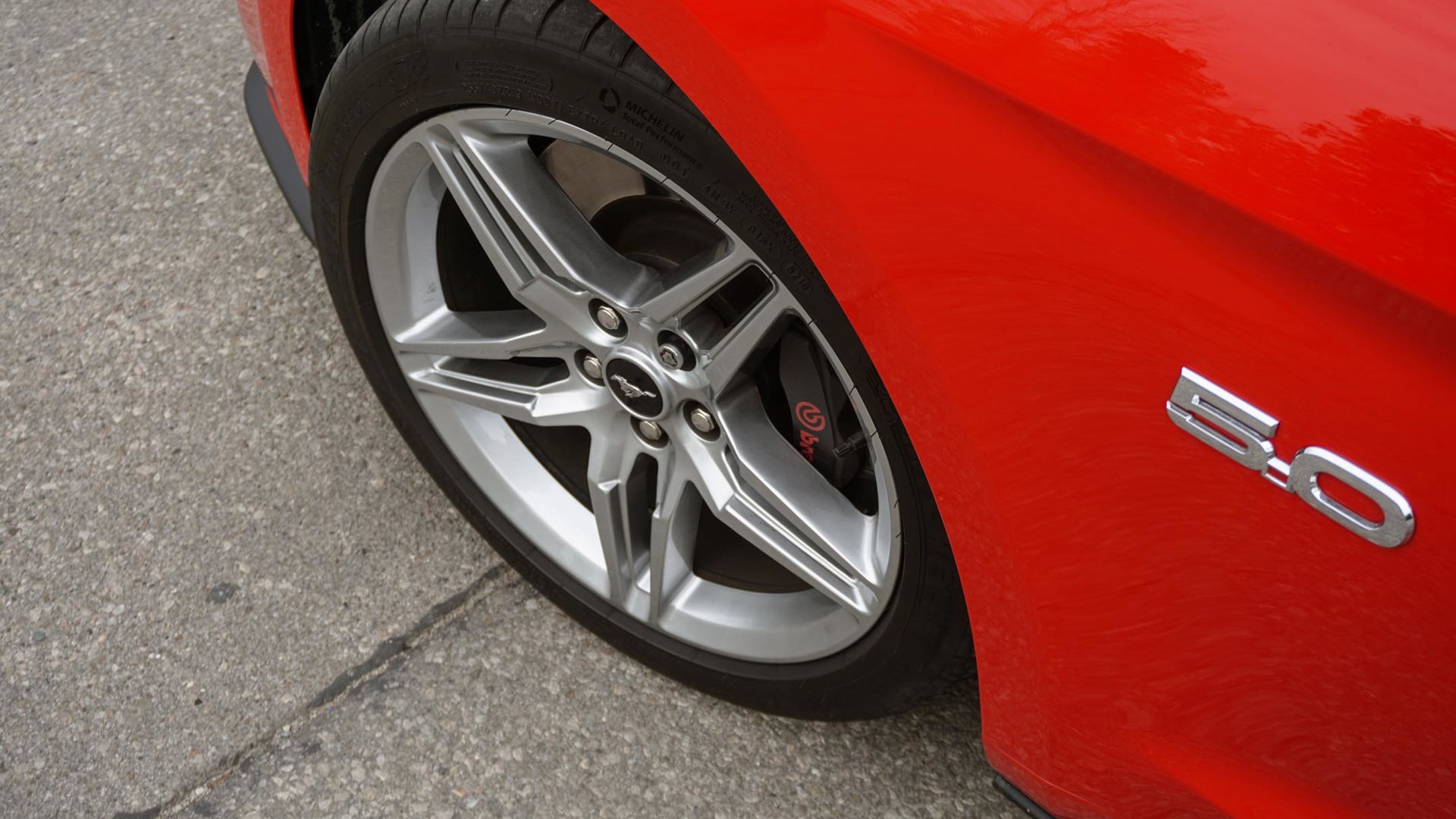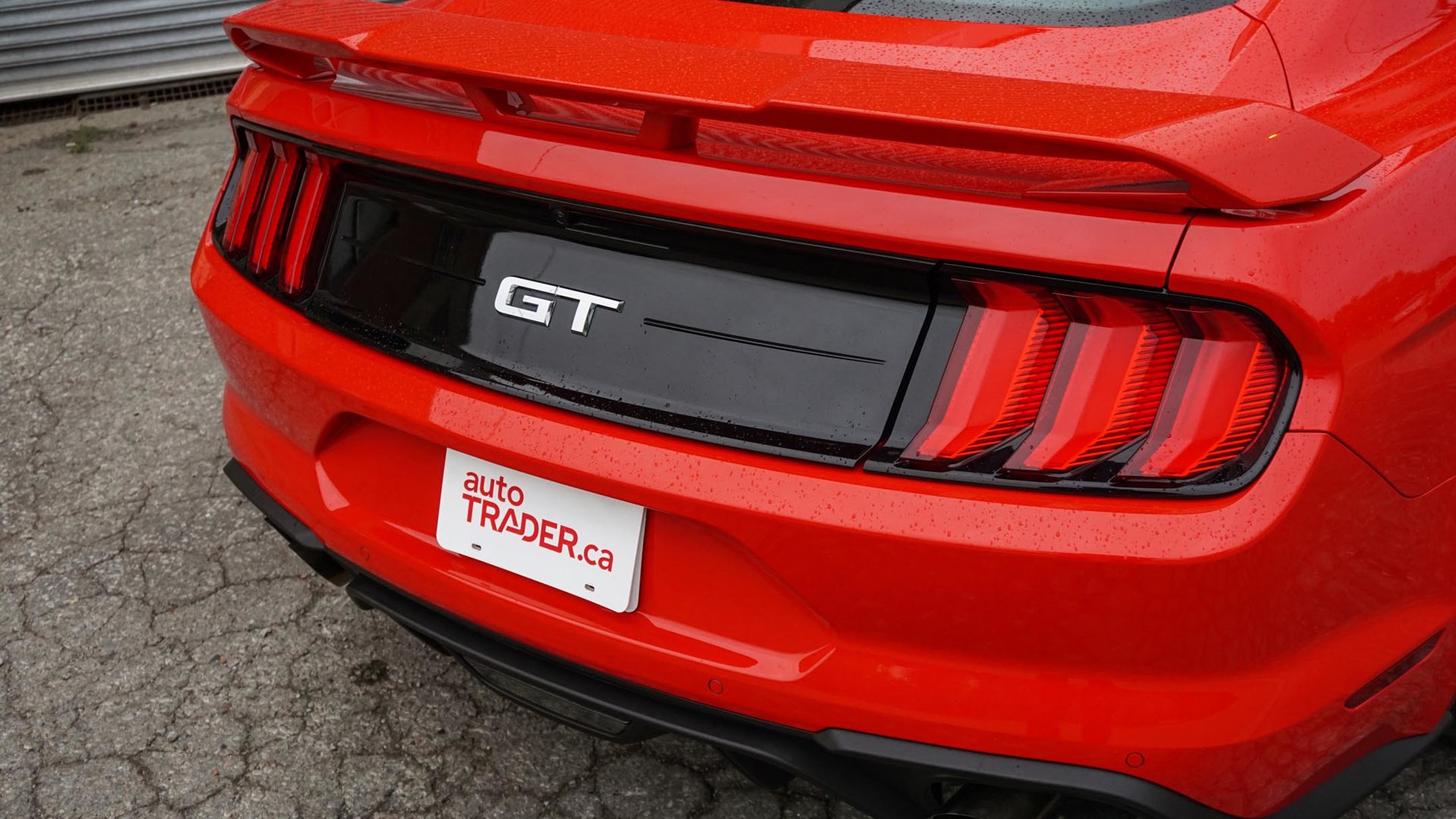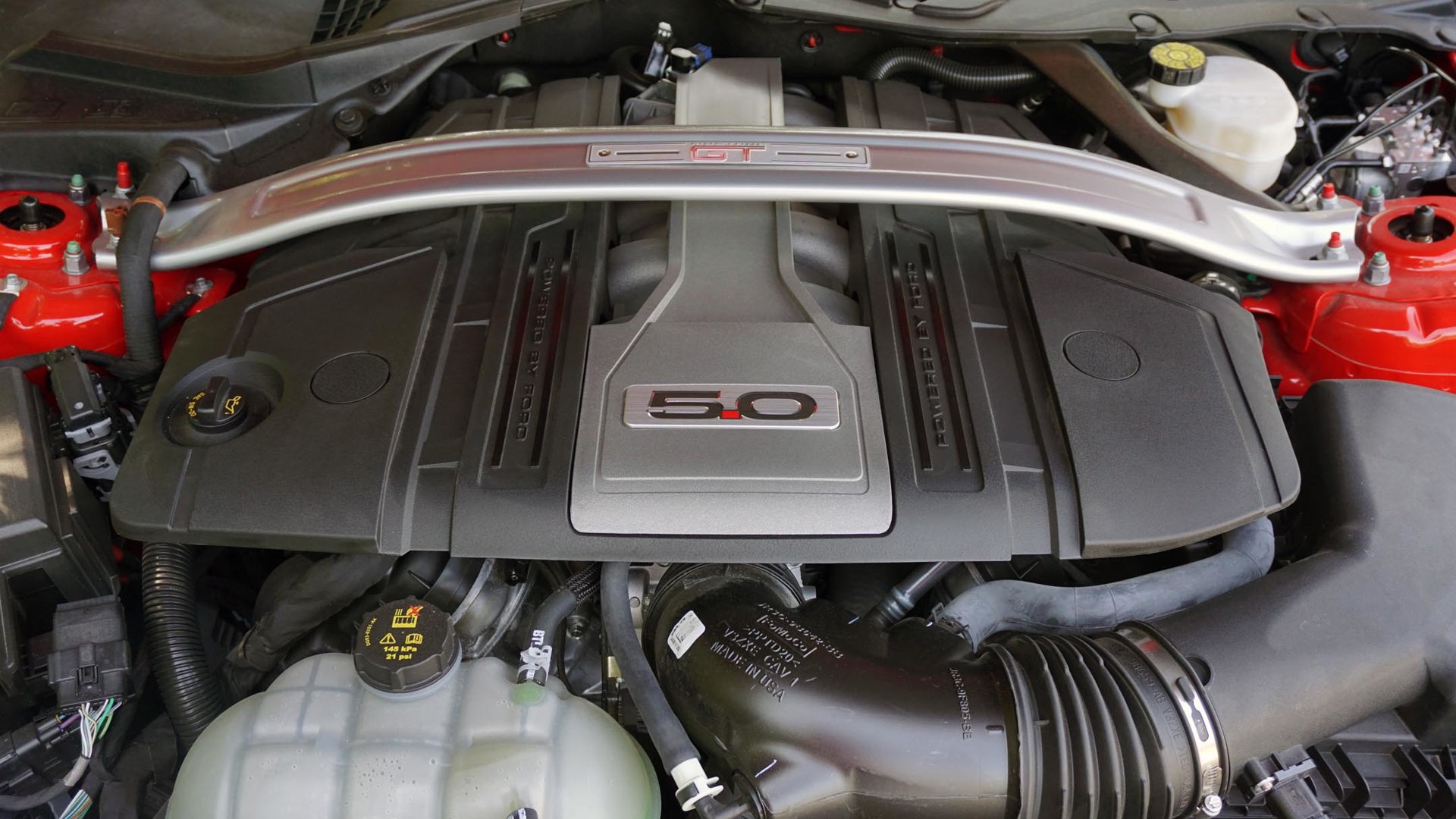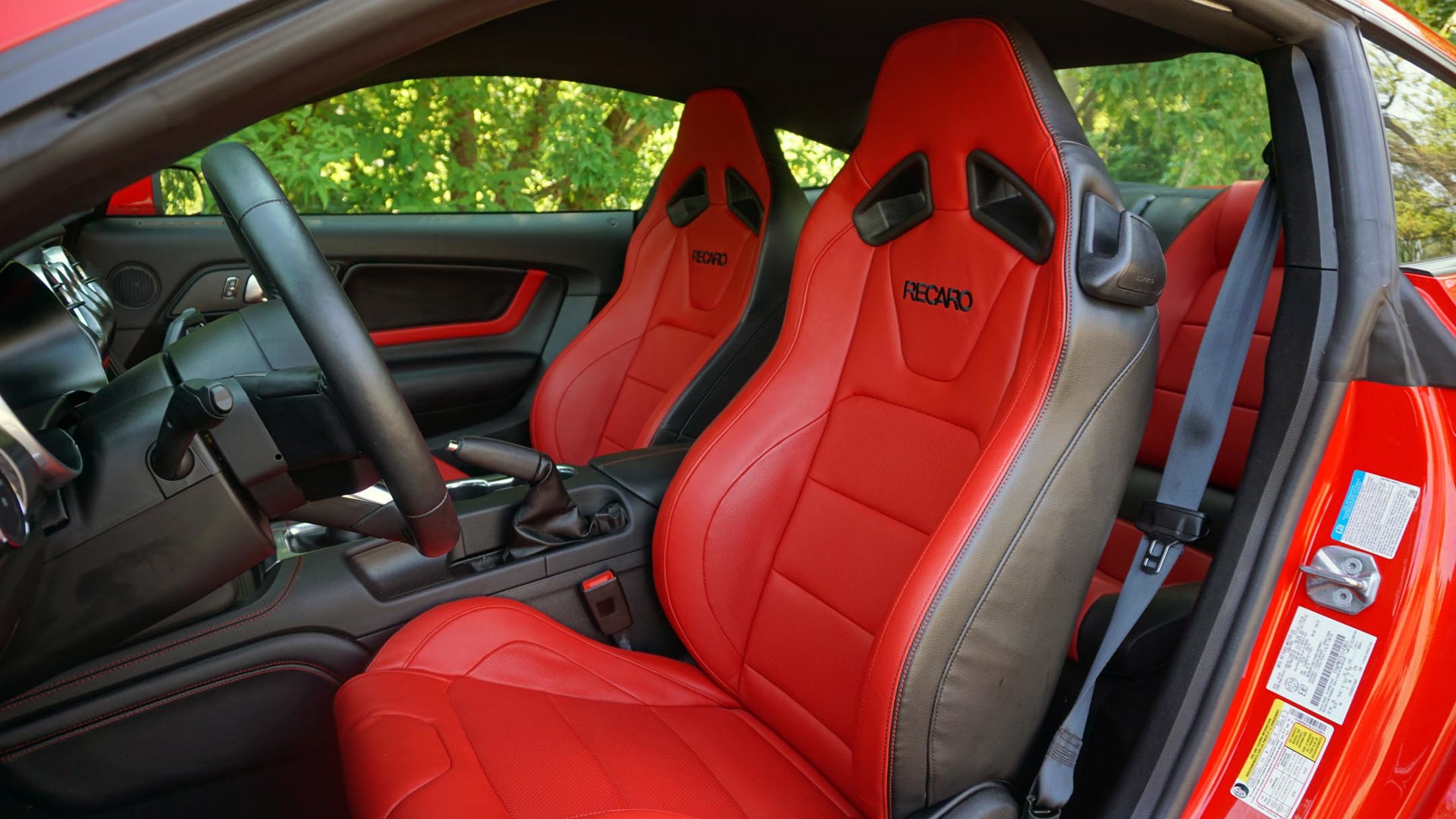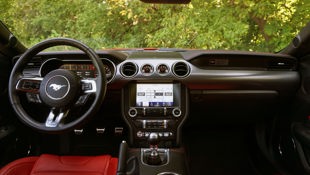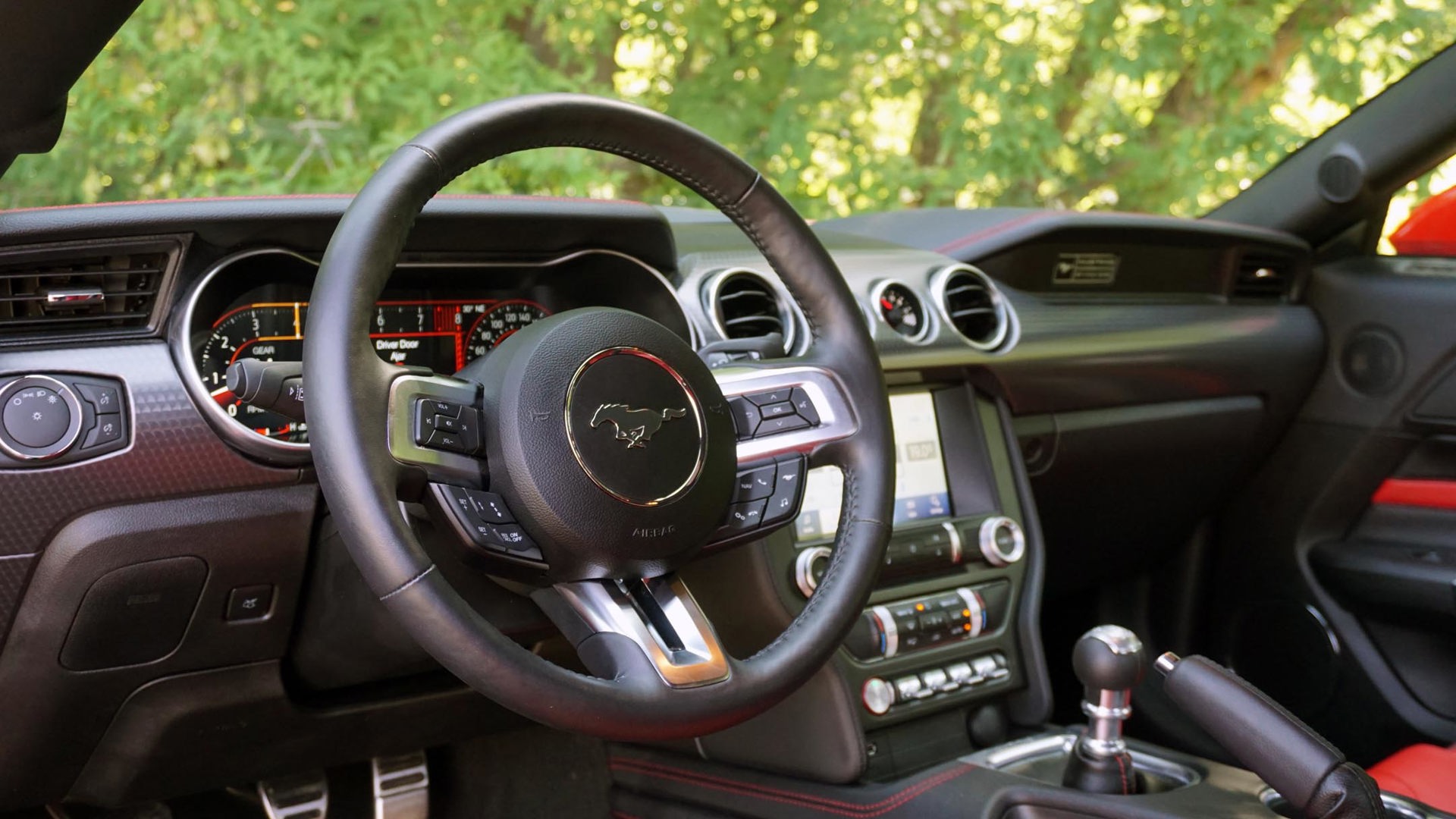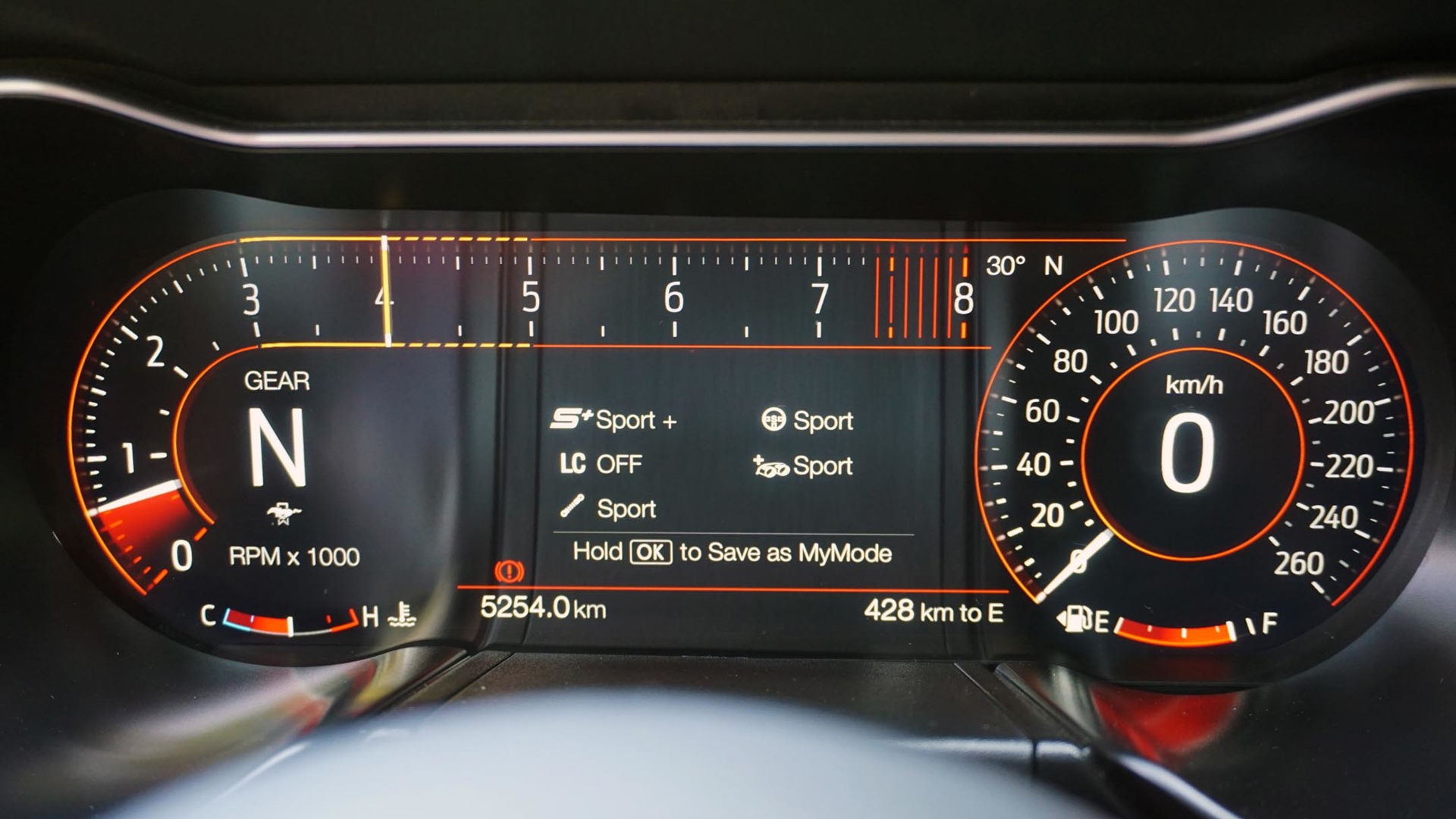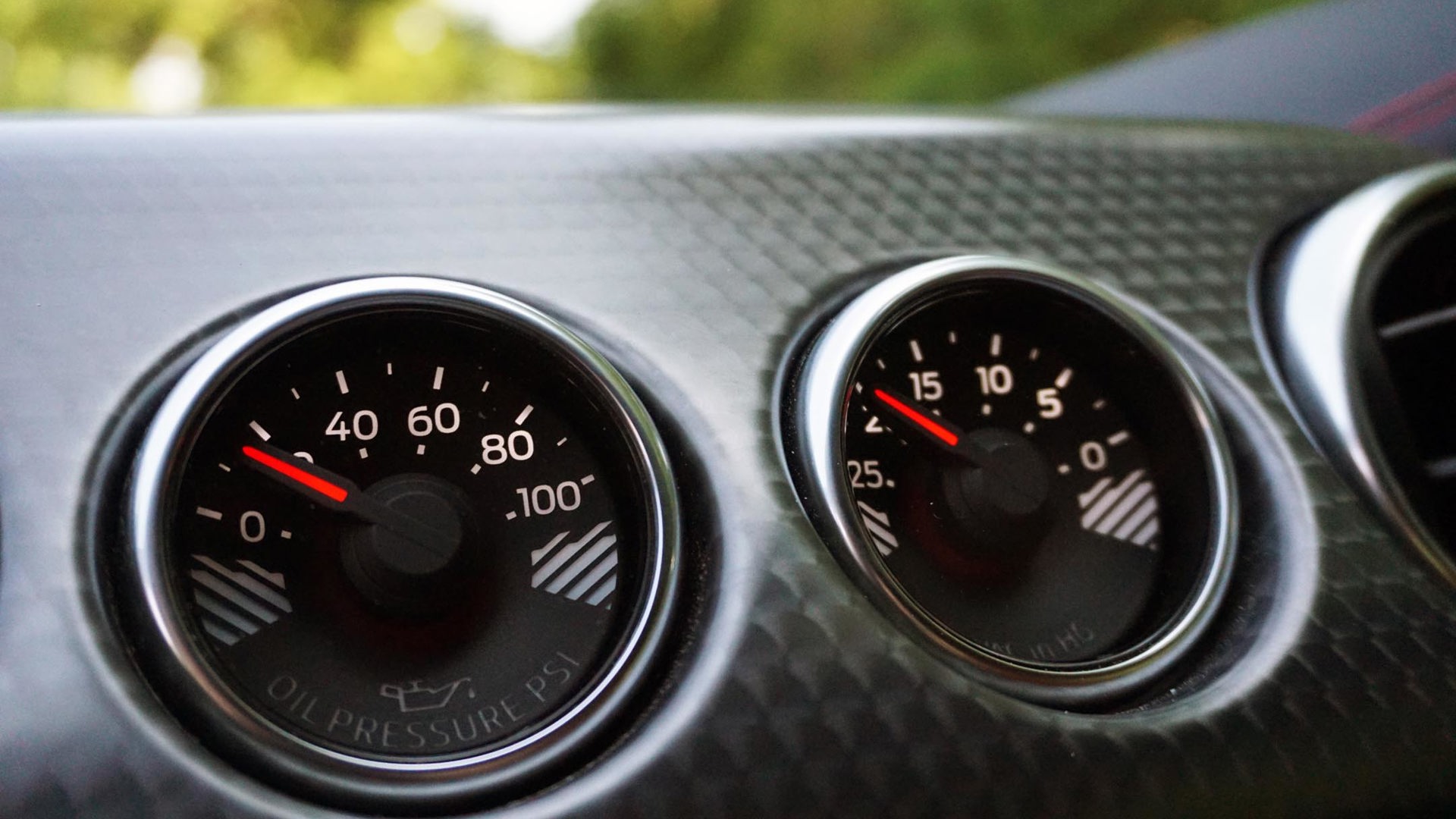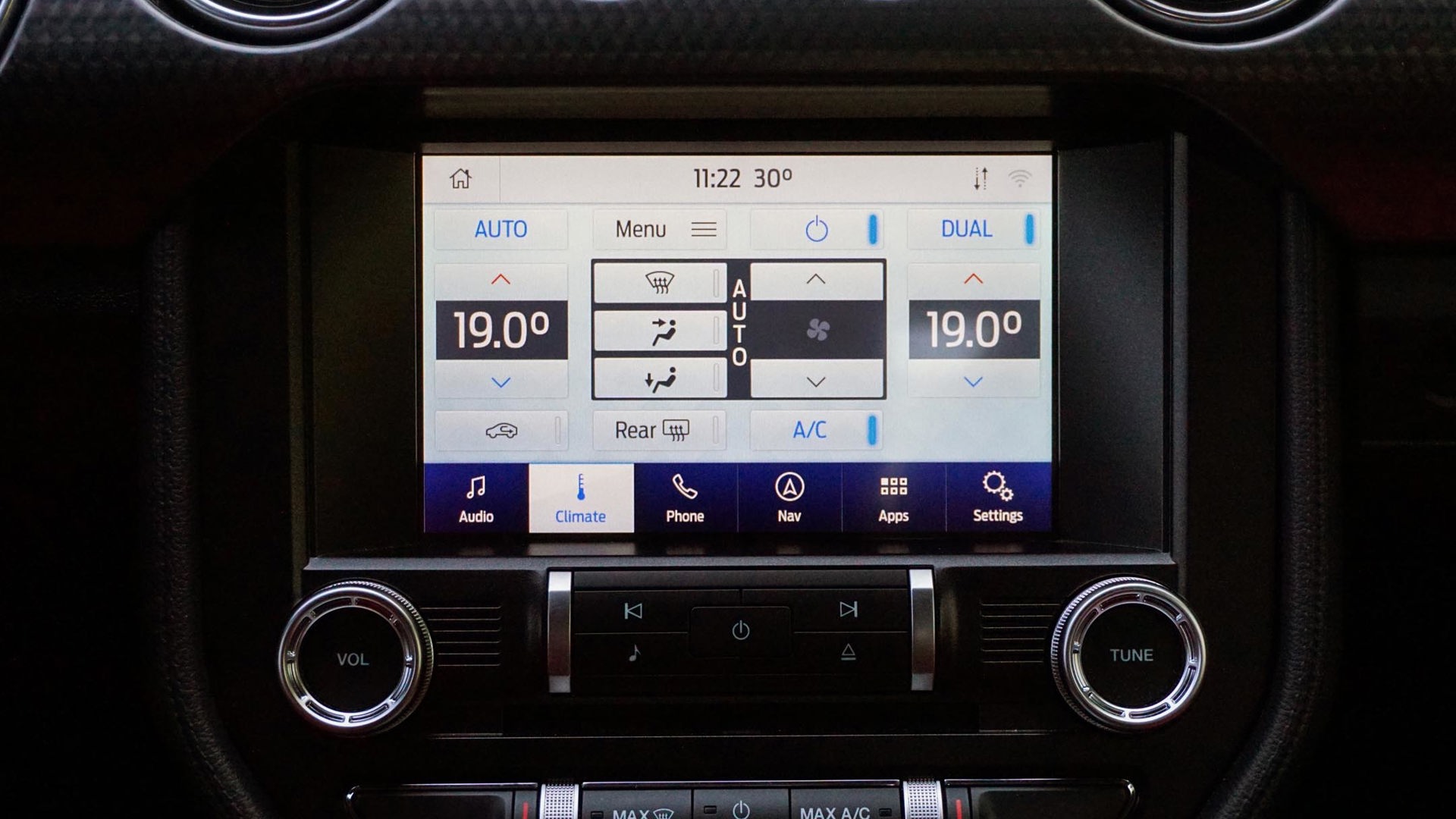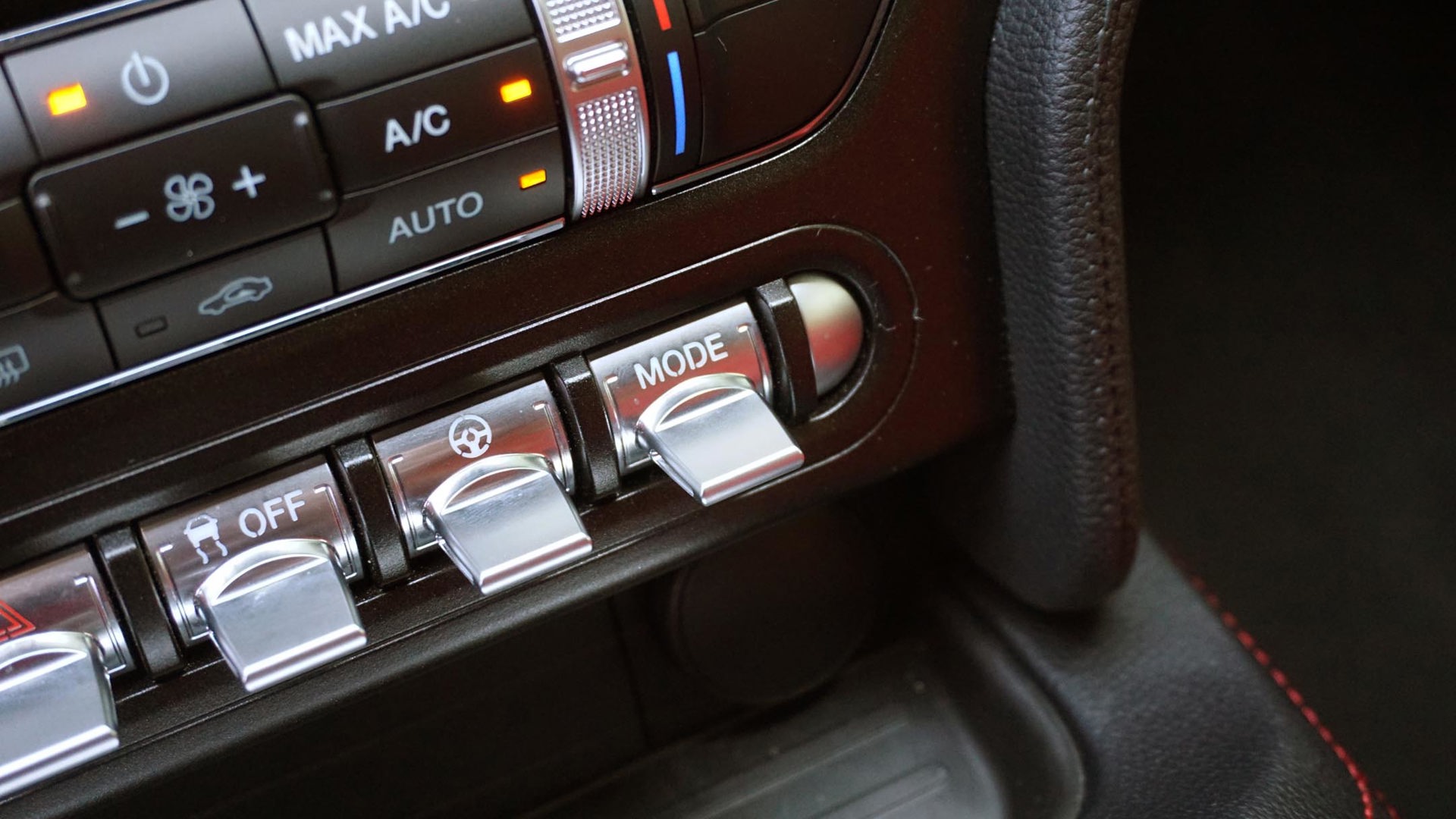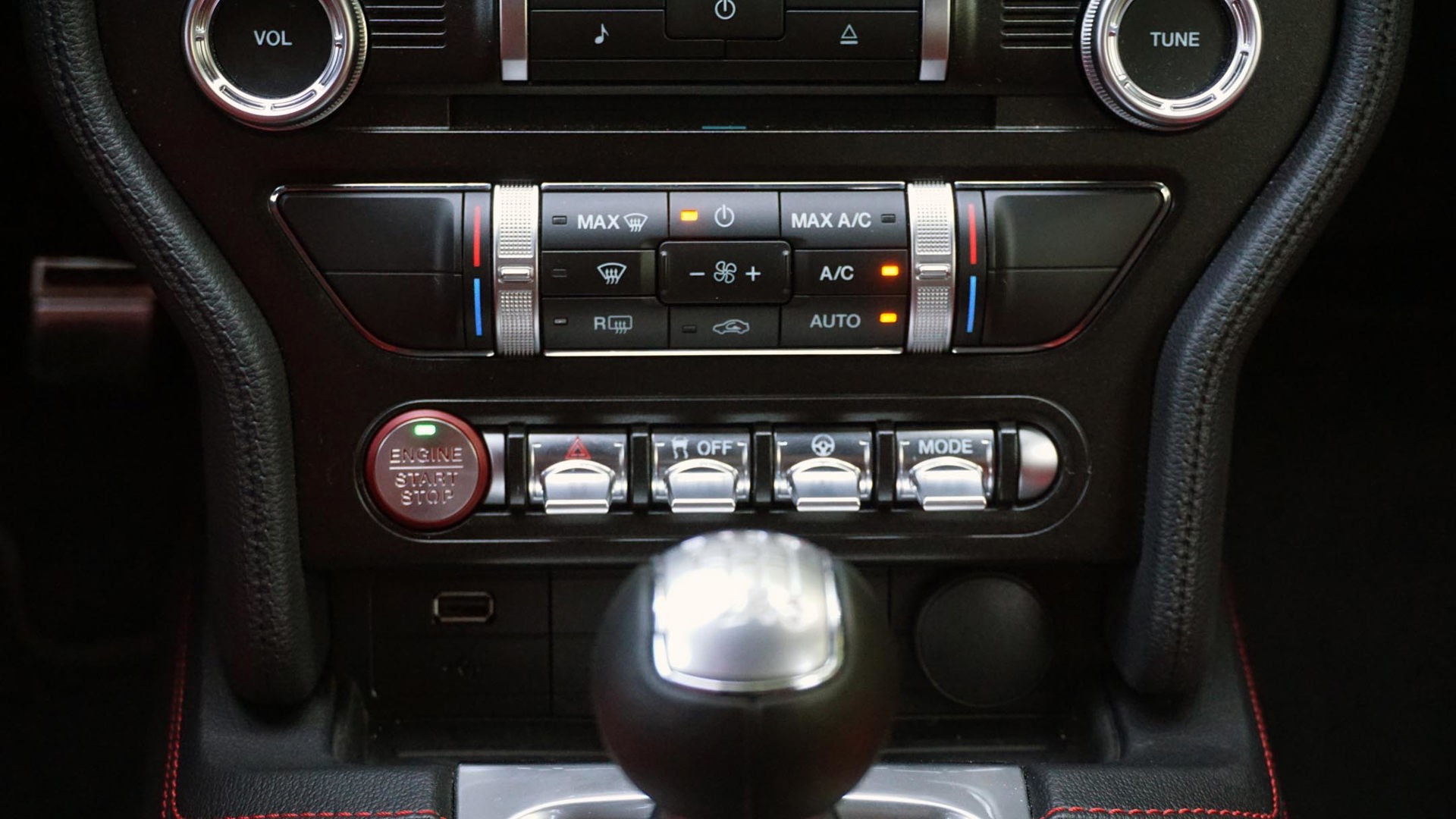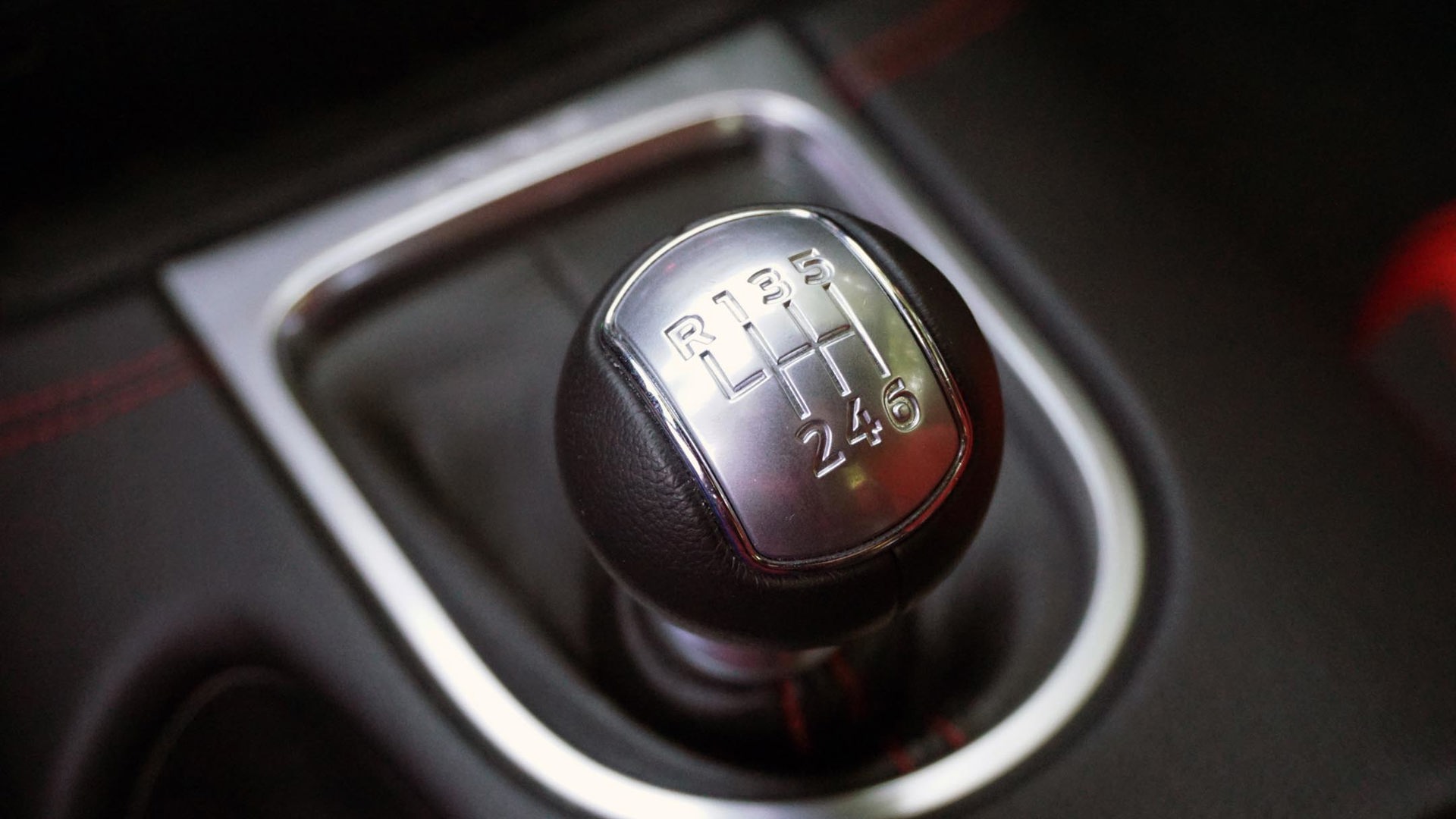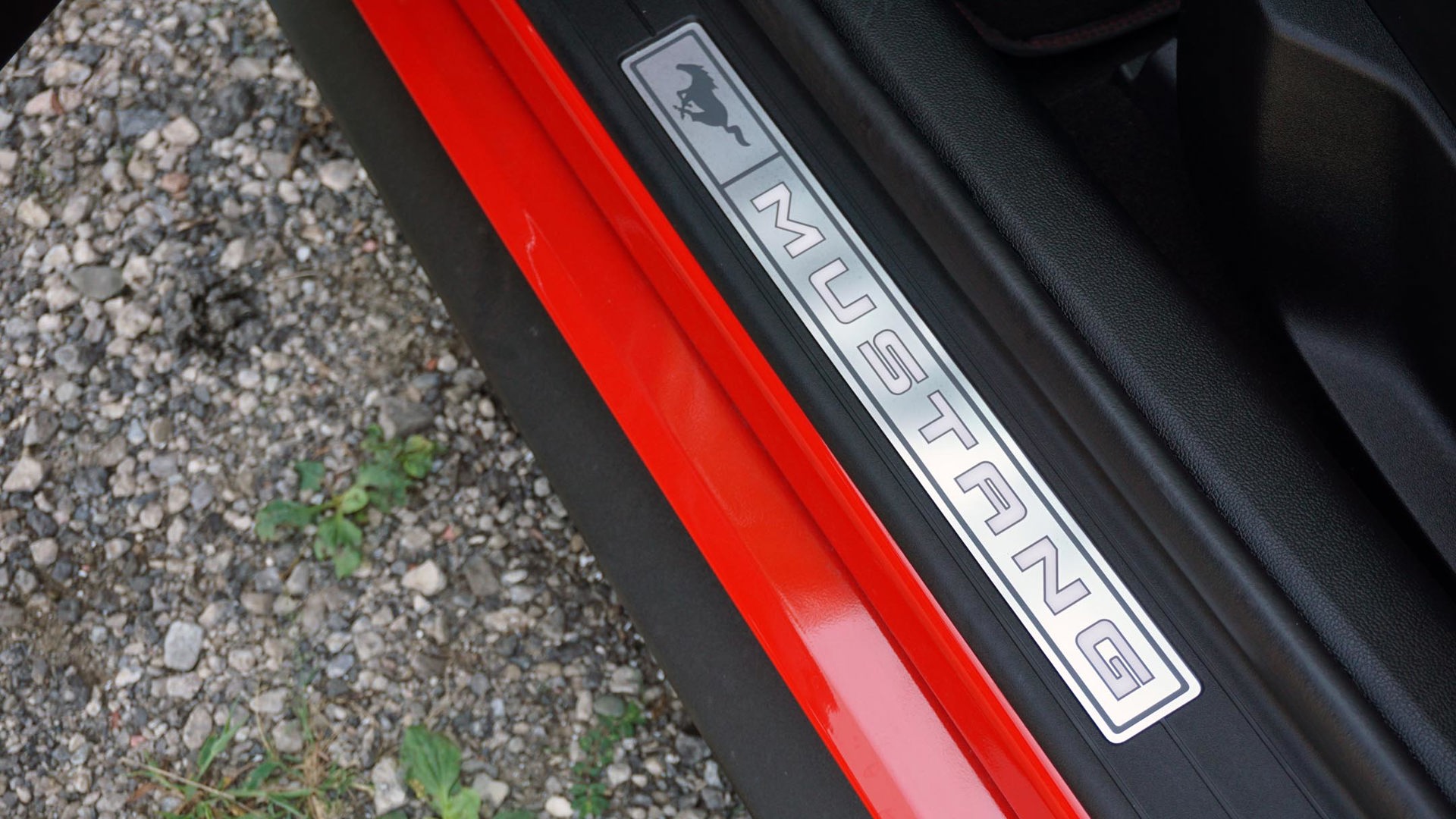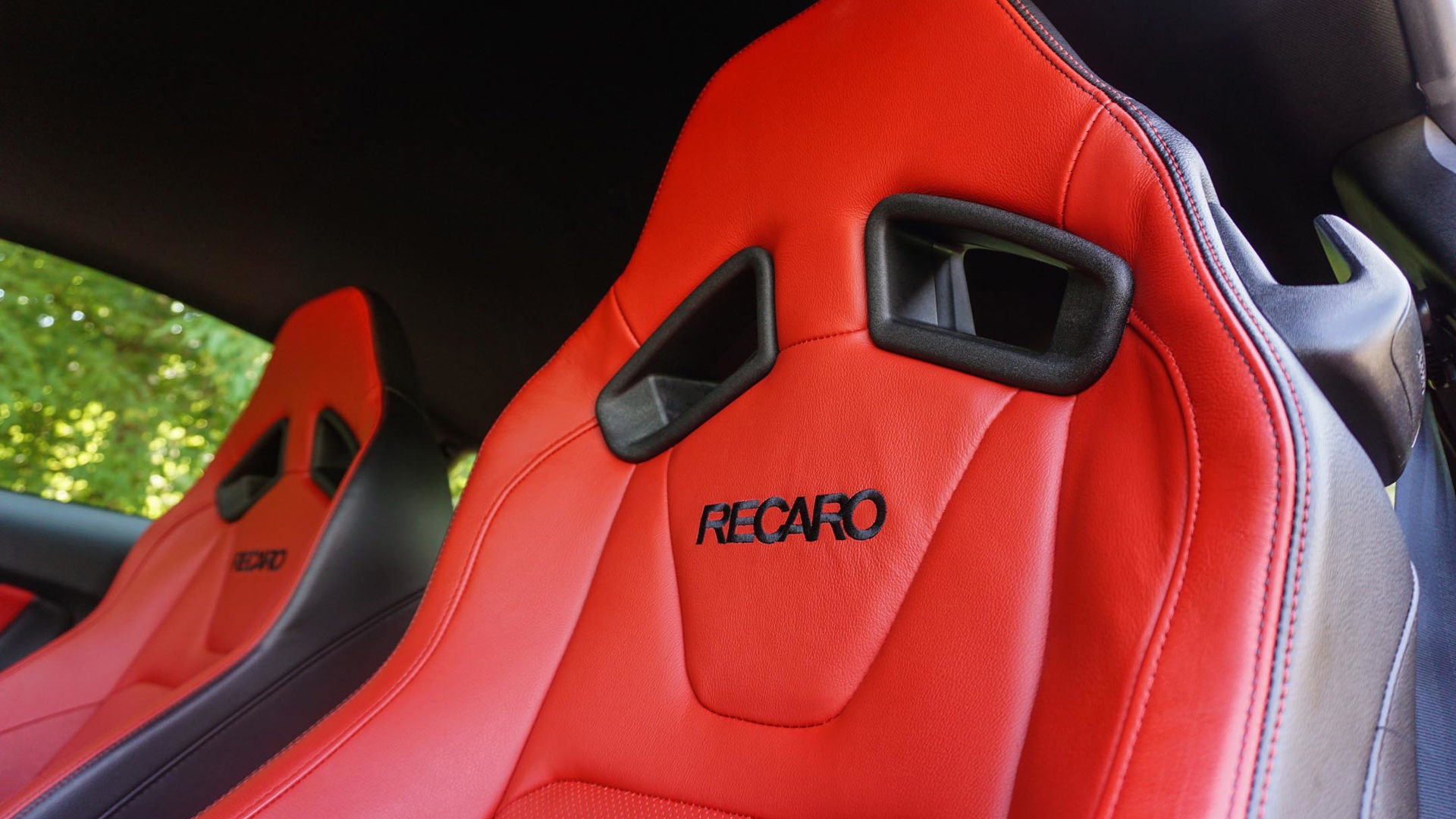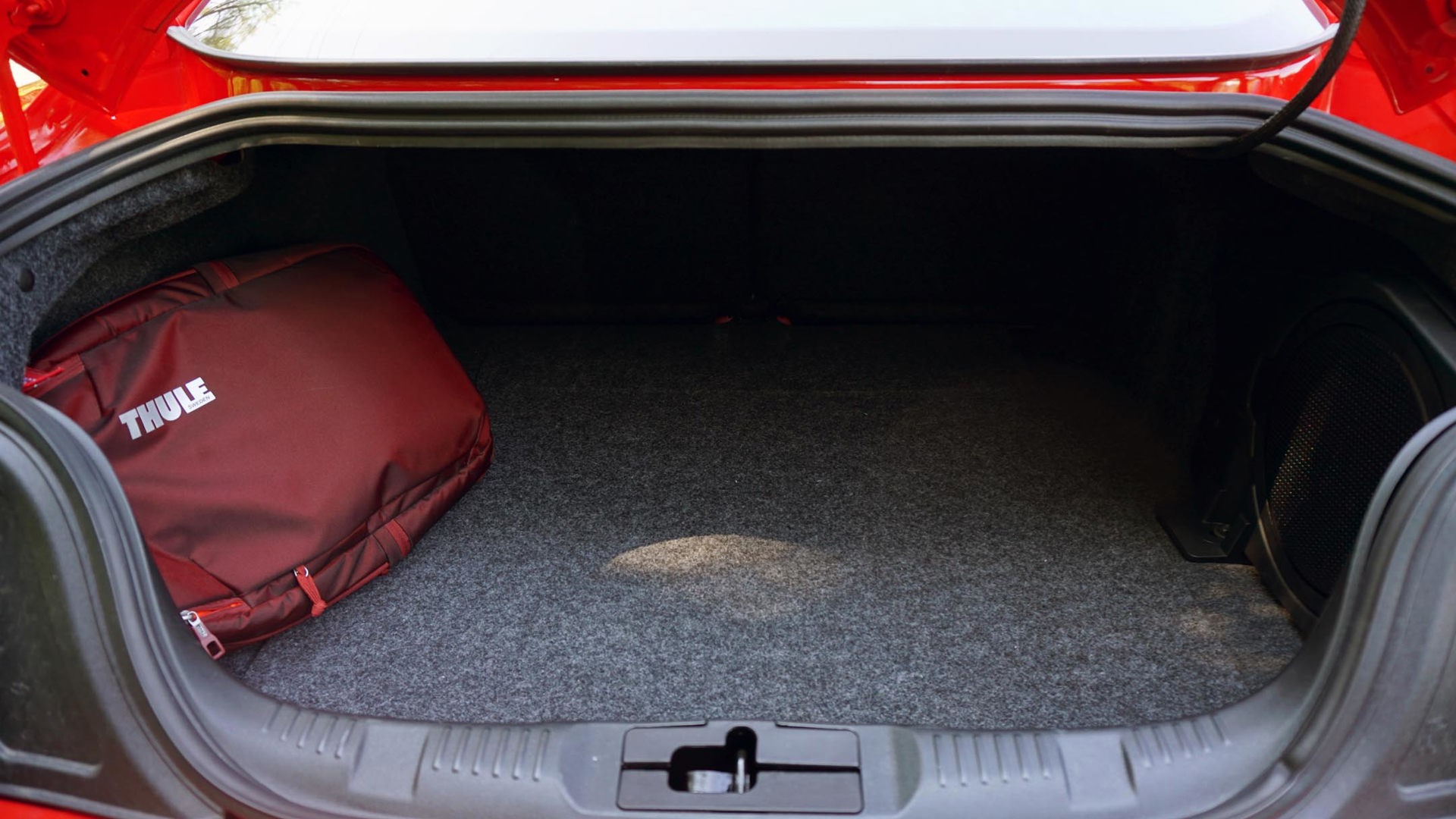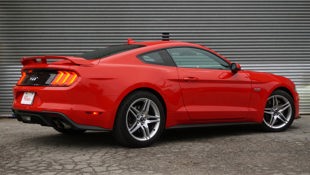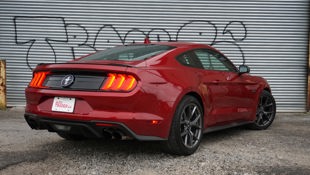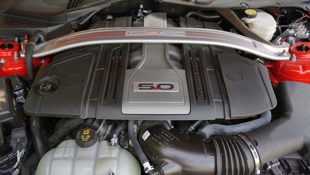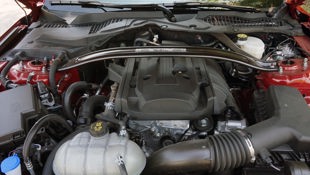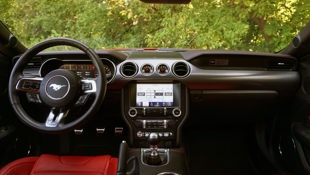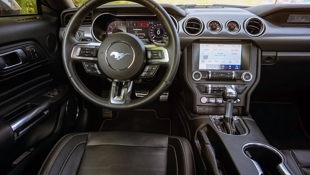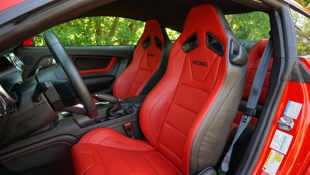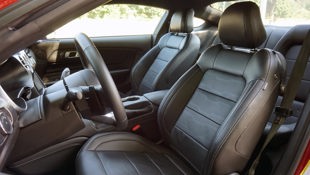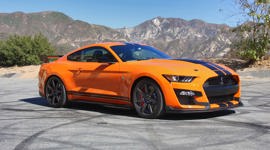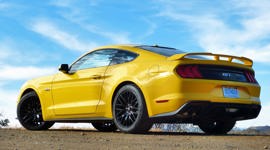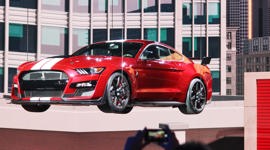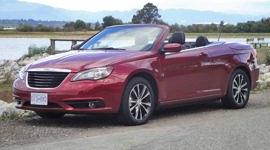Comparison Data
|
2020 Ford Mustang EcoBoost Premium
|
2020 Ford Mustang GT Premium
|
|---|---|
|
Engine Displacement
2.3L
|
5.0L
|
|
Engine Cylinders
Turbo I4
|
V8
|
|
Peak Horsepower
330 hp @ 5,500 rpm
|
460 hp @ 7,000 rpm
|
|
Peak Torque
350 lb-ft @ 3,000 rpm
|
420 lb-ft @ 4,600 rpm
|
|
Fuel Economy
11.8 / 8.4 / 10.3 L/100 km cty/hwy/cmb
|
16.1 / 9.9 / 13.3 L/100 km cty/hwy/cmb
|
|
Cargo Space
383 L
|
383 L
|
|
Base Price
$37,365
|
$48,025
|
|
A/C Tax
$100
|
$100
|
|
Destination Fee
$1,750
|
$1,750
|
|
Price as Tested
$54,365
|
$66,175
|
|
Optional Equipment
$15,150 – High-Performance Package, $6,500; Handling Package, $2,600; Premium Plus Package, $2,100; 10-Speed Automatic Transmission, $1,750; 12-Speaker Stereo, $1,000; Enhanced Security Package, $700; Rapid Red Metallic Paint, $500
|
$16,300 – Performance Package, $4,200; Magne-Ride Damping System, $2,500; Premium Plus Package, $2,100; Recaro Leather Sport Seats, $1,800; 19-Inch Luster Nickel-Plate Wheels, $1,500; Safe and Smart Package, $1,500; Active Valve Exhaust System, $1,000; Enhanced Security Package, $700; 12-Speaker Stereo, $1,000
|
It’s not necessarily that we’re traditionalists at autoTRADER.ca, but there’s something about V8 power that just feels right in a Ford Mustang.
That’s the way it’s always been, sure, but it still makes an awful lot of sense from a performance perspective, too. That’s why, despite all the changes the Mustang has undergone over the years, a hearty eight-cylinder is still offered under the hood.
Yet here we are, the only available alternative a turbocharged four-cylinder – an engine some might call the antithesis of everything a car like this should stand for. Except this one packs enough of a unique performance punch to give us pause for thought.
Power
As far as pure output is concerned, the 5.0L easily outguns the 2.3L that’s nestled between the fenders of the Ford Mustang EcoBoost. There will be no mistaking the sounds the small motor makes for its fire-breathing brethren anytime soon. Yet there’s also no denying Ford the credit it deserves for squeezing so much out of the tiny turbo motor – especially with the high-performance pack tacked on.
The version of the 2.3L found here is borrowed from the since-retired Ford Focus RS that we loved so dearly, with output topping out at 330 hp and 350 lb-ft of torque (the former number drops to a still-impressive 310 hp without the upgrade). While peak torque doesn’t kick in until 3,000 rpm, the vast majority of it – 90 per cent, to be precise – remains available right up to the engine’s 6,500 rpm redline. The turbo’s slow spool results in something of a delay off the top, but the reward is a pleasing bit of quickness once enough combustible force is built.
Of course, the four-cylinder can’t hold a candle to the 5.0L based on numbers alone. Cranking out 460 hp and 420 lb-ft of torque, this burly V8 is a reminder that the Mustang is still a muscle car despite its transformation over the years into something far more sporty and precise. With the optional sport exhaust in its loudest setting, the Mustang GT is intent on informing everyone within earshot of what it’s packing under the hood.
Without the troublesome turbo lag of the four-cylinder, the Coyote V8 is playful from the jump – and it’s not afraid to send the tail end of the car sideways should throttle input err on the eager end of the equation. The 5.0L revs higher, too, clocking in with a redline of 7,400 rpm. It’s most interested in hanging out above 4,800 rpm, the forceful nature of all that torque taking full effect as the V8 roars its way to the limiter.
GT: 10/10; EcoBoost: 9/10
Driving Feel
There’s an intimidation factor that comes with driving the Mustang GT, and the 5.0L is the source. The active exhaust certainly adds to it, the menacing snarl more than enough to make palms sweat and nerves swirl. That it’s so easy for the Ford’s hindquarters to step out for its own view of the road ahead only adds to the exhilaration. It requires the same amount of patient throttle modulation as any V8-powered pony car, with a propensity for its hips to waggle in response to deep stabs of the throttle.
Paired with a stellar six-speed manual transmission that employs one of the best clutch pedals around and built-in automatic rev-matching, the Mustang GT is a driver’s delight. While the steering comes off as rather artificial, weight can be added – or subtracted – depending on setting for a sense of resistance to match all of the weight over the front wheels.
The version we tested was done up with a bunch of additional chassis stiffeners and stickier summer tires, all part of the GT performance pack, as well as magnetorheological adaptive dampers, giving the car a flatter, firmer feel when cornering.
None of it’s enough to make the V8 version as nimble as the EcoBoost, however; freeing up about 140 kg (309 lb), most of which sits ahead of the driver, has a way of altering a car’s behaviour for the better. The four-cylinder might not be as fast in a straight line, but through a winding road – and with much of the same chassis and suspension upgrades along for the ride – it’s a completely different car, and makes quicker work of the tightest of turns.
There’s little doubt the turbo car is more enjoyable when paired with the standard six-speed manual transmission rather than the 10-speed automatic fitted to our tester. It’s not that the gearbox is bad, but it strips away some of the Mustang’s personality. It also proved reluctant to let the driver take charge via the steering-wheel-mounted paddle shifters during testing, responding slowly – and sometimes not at all – to downshift requests.
The automatic was also occasionally clunky, too, misbehaving when the throttle pedal was pressed to add more momentum at cruising speed. It’s disappointing if only because the 10-speed is usually so quick to snap off shifts – especially in its sport setting.
GT: 8/10; EcoBoost: 9/10
Comfort
It’s not quite as agile as, say, a Mazda MX-5 or Toyota 86/Subaru BRZ, but the trade-off is that the Mustang is worlds more comfortable than those competitors. That goes for both cars tested here, particularly with their adaptive dampers in their softest settings.
There’s a slightly higher degree of ride quality in the Mustang GT, though it’s barely perceptible and is most likely a byproduct of the different spring rates required to counter the extra weight of its engine. Otherwise, both cars are capable highway cruisers, though the four-cylinder’s exhaust note tends to drone unless set to silent mode (and even then it kicks back in at an awkward octave as soon as the accelerator pedal is pressed).
Either version can be optioned with Recaro sport seats, though here it’s only the Mustang GT that’s fitted with the upgraded buckets. While they’re mostly comfortable – and their extra bolstering is a blessing when a playful mood strikes – the chairs grip just a little too tight around the love handles to border on unpleasant for occupants like your author (autoTRADER.ca Editor-in-Chief Jodi Lai had no such trouble).
Stepping up to the Premium trim level gives both driver and passenger heat and ventilation for their leather-lined seats, except swapping them for the optional Recaros means losing both climate functions. Whether it’s worth the sacrifice ultimately comes down to the end user’s plans, but even on a track day having seat ventilation is worth the minimal weight it adds. (For what it’s worth, over at Chevrolet a Camaro with the same style seats keeps both features.)
GT: 9/10; EcoBoost: 9/10
Practicality
As far as coupes go, the Mustang provides plenty of room. The trunk is generously sized even by sedan standards, with the 383 L to work with not from what’s offered in the Subaru Legacy or Toyota Camry. The rear opening isn’t especially wide, but it’s a deep cargo hold that can swallow a golf bag with room to spare.
The Mustang’s 2+2 seating means – in theory, at least – space for four occupants. In reality, the cabin is best suited for two people to sit up front and that’s about it. Since there’s no sunroof offered (those looking to catch some rays can make their way across the showroom and into the Mustang convertible), headroom is generous enough to accommodate helmets when it’s time to hit the track or drag strip.
GT: 9/10; EcoBoost: 9/10
Features
Despite their low-level status in the Mustang performance hierarchy – Shelby-badged models like the GT350 and bonkers GT500 are at the pinnacle – neither car tested here would be out of place at an open-lapping day or a night at the dragway. That’s because both come fitted from the factory with plenty of go-fast features, while even more can be added through the options list.
Different drive modes tailor the powertrain to whatever the driver has planned, while manual models get launch control, too. With their respective performance packages added, both the GT and EcoBoost get a host of chassis and suspension upgrades, as well as sticky summer tires, upgraded brakes, and bigger radiators, while the turbocharged four-cylinder also gets that horsepower bump and the upgraded exhaust system. The optional adaptive dampers, meanwhile, can be added to either version.
In Premium guise, both cars get dual-zone automatic climate control, Apple CarPlay and Android Auto, a subscription-based Wi-Fi connection, and a nine-speaker stereo. On top of that, there are plenty of upgrades offered, ranging from a heated steering wheel to a 12-speaker stereo and adaptive cruise control.
GT: 8/10; EcoBoost: 8/10
Safety
A bunch of airbags are packed into the cabin to keep occupants safe in the event of a crash, and advanced safety equipment like automatic emergency braking, lane-keep assist, and blind-spot monitoring can be added. There’s also a government-mandated backup camera built in.
Of the two cars tested here it was the Mustang GT that came fitted with those extras and they worked well. The lane-keep system provides gentle nudges and reminders, but most importantly it’s easy to disable via a button on the end of the turn signal stalk. The forward collision warning system, meanwhile, utilizes a row of flashing lights that reflect off the windshield to deliver its message, though it’s not easily triggered.
GT: 9/10; EcoBoost: 9/10
User Friendliness
Turning the forward collision system off isn’t quite as straightforward as the lane-keep assist, but it’s easily found through the optional digital gauge cluster. Ditto the active exhaust, which can be toned down through the same screen, or set for quiet starts to keep neighbours happy.
The steering wheel is fitted with logical controls to manipulate those functions and more, while the dash features a simple smattering of HVAC and audio controls below a central touchscreen infotainment system. That’s also where the row of toggle switches for the Mustang’s drive modes, steering, and traction control can be found, all of which are simple enough to figure out without the need to crack open the owner’s manual.
Ford’s infotainment interface isn’t especially noteworthy, with a dated look and feel and the occasional lag in response – especially right after it boots up. The standard Apple CarPlay also isn’t without its problems, sometimes failing to recognize a connected device. It’s most common if the car is shut off and then on again after a short period – say, when running into a store – but is a frustrating foible nonetheless. (This is becoming a common theme amongst Ford models we’ve tested, with the Ranger and Expedition suffering from the same issue.)
While the plus-sized doors make parking lots something of a problem they also make climbing into and out of the Mustang easy. Once inside the outward view is good for a sports car, though the door mirrors aren’t especially large.
GT: 9/10; EcoBoost: 9/10
Styling
With a low-slung stature and an elongated hood, the 2020 Ford Mustang is almost perfectly proportioned to our eyes. It’s squinting headlights and gaping grille give the coupe an aggressive look, while the rear end is set off by its quad exhaust tips and classic Mustang taillights.
Painted in a rich candy-apple red contrasted by dark grey accents that come with its performance package, it was the EcoBoost version that won our impromptu beauty pageant.
Inside, the Mustang GT garnered far more attention, though not all of it was positive. While we’re generally big fans of colourful interior treatments, the red-on-black-on-red theme of this particular tester was a little much even for the autoTRADER.ca team. As Jodi so perfectly put it, the colour combination makes the car look like an awful lot like Eddie Murphy’s outfit in his “Delirious” stand-up special circa 1983.
GT: 8/10; EcoBoost: 9/10
Fuel Economy
The Ford Mustang’s appetite for fuel is such that anyone predicating a purchase upon this parameter would be best to shop elsewhere – or at worst stick with the EcoBoost.
It’s not as if the Mustang GT burns more premium-grade gasoline than any of its V8-powered competitors – Natural Resources Canada (NRCan) rates the manual model at a combined 13.3 L/100 km – but it’s certainly no fuel-miser. Real-world testing saw the car burn an average of 15.0 L/100 km.
With its upgraded engine and 10-speed automatic, the Mustang EcoBoost is rated by NRCan to return a combined average of 10.3 L/100 km. The final results came in slightly better than that, burning 9.7 L/100 km with lots of highway-biased driving.
Both cars run on a recommended diet of 93-octane gas.
GT: 6/10; EcoBoost: 7/10
Value
Opting for the EcoBoost won’t just save money at the pumps but in monthly payments, too. The cheapest four-cylinder model starts at $31,080 before freight and taxes. That’s competitive with the twins from Toyota and Subaru, and almost $10,000 less than the entry-level Mustang GT.
With the V6 model no longer between them – and let’s be honest: that was a rental-car special at best, with autoTRADER.ca contributor Stephen Elmer the only person we know who actually liked that engine – there’s a pretty big gulf between these two cars, though the 2.3L performance pack is something of a stopgap (it’s a $6,500 upgrade to the EcoBoost).
The Premium models shown here start at $37,365 before fees and taxes are applied for the four-cylinder, and $48,025 for the V8 version with the same caveats. Once all the goodies were added to the testers here, final pre-tax pricing registered at $54,365 for the Mustang EcoBoost and $66,175 for the Mustang GT. Both price tags are big pills to swallow, though incentives could easily bring them down to the point that they’re more reasonable.
GT: 6/10; EcoBoost: 6/10
The Verdict
For those firm in their convictions that there really is no replacement for displacement, the Mustang GT and its fiery 5.0L truly is the only way to go. It’s also a tremendous muscle car – if a seriously modern one – that delivers an insane amount of output for the price. It’s certainly the more intense of the two cars, packing a heavy punch and sounding as outrageous as anything else on the market.
But it was the Mustang EcoBoost that surprised us most for its divergent approach to performance. Dynamic and agile, it drives like an altogether different car. Yes, the Mustang in general handles better than it ever has in its sixth generation, but the turbocharged model takes the transformation from muscle car to sports car to another level.
It’s missing the ferocious and familiar sounds of Mustang models of old, a sticking point for at least some of us at autoTRADER.ca. It’s also not the same silly plaything as the Mustang GT, which takes some getting used to. But it’s an awfully impressive machine that can be pointed and shot in any direction a Mazda MX-5 can, with the added bonus of way more power and room. We say give us the Mustang EcoBoost with a manual transmission and the high-performance package, and maybe even those Recaro seats – but we’ll stick with a colour that’s a little less delirious, thank you.

